Paul van Yperen's Blog, page 308
May 22, 2017
Rellys
French actor Rellys (1905-1991) had an exceptional long career. First he specialised in the Marseille-set operettas by Marcel Pagnol and others. Later he often appeared as a side-kick in comedies with Fernandel.
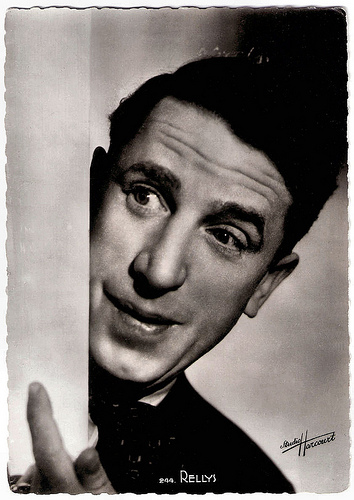
French postcard by Editions P.I., Paris, no. 199. Photo: Gray-Film.
Brioche
Rellys was born as Henri Roger Marius Bourelly in Marseille, France, in 1905. As a child, Rellys accompanied his parents on a picnic in les pinèdes and there he learned to sing.
Henri Rellys worked as a pastry chef, and earned the nickname ‘Brioche’ (Bun). As a theatre amateur, he won a singing contest at the Alcazar in Marseilles, disguised as a comic trooper in 1925.
After his military service, he was hired under the name of Rellys, for tours along cabarets in the Provence and in North Africa.
He made his film début in Le Tampon du Capiston/The plug of the capiston (Joe Francis, Jean Toulout, 1930). In the revue En plein soleil (In Full Sun) he imitated Maurice Chevalier and ... Josephine Baker .
In 1933, Henri Alibert engaged him for the company of his play Au pays du soleil (In the land of the sun). The film adaptation, Au pays du soleil (Robert Péguy, 1933), helped to launch his career. Marcel Pagnol gave him the chance to play a small part in his film Merlusse (Marcel Pagnol, 1934).
In the beginning, he specialised in Marseille-set operettas, which were flourishing at the time: Trois de la marine/Three of the Navy (Charles Barrois, 1934), César/Cesar (Marcel Pagnol, 1936) with Raimu , and Un de la canebière/One of the canebière (René Pujol, 1937) based on the operetta by Alibert, René Sarvil and Raymond Vincy, and music by Vincent Scotto.
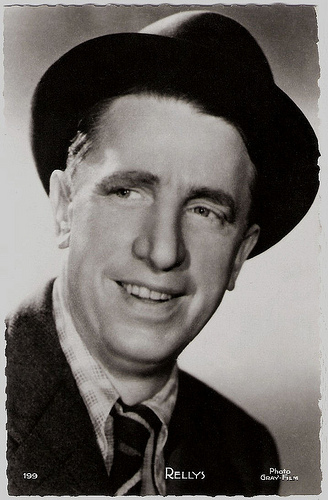
French postcard by Editions P.I., Paris, no. 199. Photo: Gray-Film.
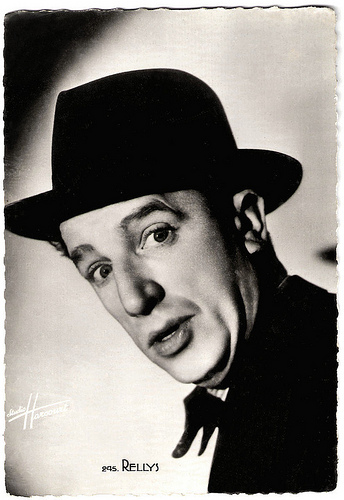
French postcard by S.E.R.P., Paris, no. 245. Photo: Studio Harcourt.
Sweet and Warm Ways
In the 1940’s, Rellys was noted for his Provençal accent, his sweet and warm ways and his endearing air. He had a real triumph with Narcisse/Narcissus (Ayres d'Aguiar, 1940), in which he played a vaudeville soldier, who has to fly an aeroplane despite himself.
He also played leading roles in Feu Nicolas/Fire Nicolas (Jacques Houssin, 1943), Roger la Honte/Roger the Shame (André Cayatte, 1945), Les Aventures des Pieds Nickelés/The Adventures of Nickeles feet (Marcel Aboulker, 1947), Tabusse (Jean Gehret, 1948) and Manon des Sources/Manon of the Spring (Marcel Pagnol, 1952).
His exceptional long career continued after the war with films like Amédée/Amedeus (Gilles Grangier, 1950), La vie est un jeu/Life is a game (Raymond Leboursier, 1951), and Arènes joyeuses/Joyful Arenas (Maurice de Canonge, 1958).
In many of his later films he supported comedy star Fernandel , including Honoré de Marseille (Maurice Régamey, 1956), Crésus/Croesus (Jean Giono, 1960), L'Âge ingrate/That Tender Age (Gilles Grangier, 1964) starring Jean Gabin , and Heureux qui comme Ulysse/ Happy He Who Like Ulysses (Henri Colpi, 1970).
His last film was L'Ange gardien/The Guardian Angel (Jacques Fournier, 1978) with former first lady of Canada, Margaret Trudeau. He also worked for television, and appeared in episodes of the crime series Les Cinq Dernières Minutes/The Last Five Minutes (1966-1973) and Madame le juge/Madam judges it (1978) starring Simone Signoret .
He returned to the songs of his early operettas in Marseille, when he released his first album in 1977. His last TV appearance was in L'honneur de Barberine/The Honor of Barberine (1982).
Rellys retired in his birthplace Marseille. There he died in 1991, at the age of 86. He had two daughters, Annie and Michèle.
Scene from Les lettres de mon moulin/Letters from My Windmill (Marcel Pagnol, 1954) with Rellys, Fernand Sardou, and Robert Vattier. Source: Marcel Pagnol (Daily Motion).
Scene from Manon des Sources/Manon of the Spring (Marcel Pagnol, 1954) with Rellys and Jacqueline Pagnol. Source: Marcel Pagnol (Daily Motion).
Sources: Ciné-Ressources (French), Wikipedia (French), and .

French postcard by Editions P.I., Paris, no. 199. Photo: Gray-Film.
Brioche
Rellys was born as Henri Roger Marius Bourelly in Marseille, France, in 1905. As a child, Rellys accompanied his parents on a picnic in les pinèdes and there he learned to sing.
Henri Rellys worked as a pastry chef, and earned the nickname ‘Brioche’ (Bun). As a theatre amateur, he won a singing contest at the Alcazar in Marseilles, disguised as a comic trooper in 1925.
After his military service, he was hired under the name of Rellys, for tours along cabarets in the Provence and in North Africa.
He made his film début in Le Tampon du Capiston/The plug of the capiston (Joe Francis, Jean Toulout, 1930). In the revue En plein soleil (In Full Sun) he imitated Maurice Chevalier and ... Josephine Baker .
In 1933, Henri Alibert engaged him for the company of his play Au pays du soleil (In the land of the sun). The film adaptation, Au pays du soleil (Robert Péguy, 1933), helped to launch his career. Marcel Pagnol gave him the chance to play a small part in his film Merlusse (Marcel Pagnol, 1934).
In the beginning, he specialised in Marseille-set operettas, which were flourishing at the time: Trois de la marine/Three of the Navy (Charles Barrois, 1934), César/Cesar (Marcel Pagnol, 1936) with Raimu , and Un de la canebière/One of the canebière (René Pujol, 1937) based on the operetta by Alibert, René Sarvil and Raymond Vincy, and music by Vincent Scotto.

French postcard by Editions P.I., Paris, no. 199. Photo: Gray-Film.

French postcard by S.E.R.P., Paris, no. 245. Photo: Studio Harcourt.
Sweet and Warm Ways
In the 1940’s, Rellys was noted for his Provençal accent, his sweet and warm ways and his endearing air. He had a real triumph with Narcisse/Narcissus (Ayres d'Aguiar, 1940), in which he played a vaudeville soldier, who has to fly an aeroplane despite himself.
He also played leading roles in Feu Nicolas/Fire Nicolas (Jacques Houssin, 1943), Roger la Honte/Roger the Shame (André Cayatte, 1945), Les Aventures des Pieds Nickelés/The Adventures of Nickeles feet (Marcel Aboulker, 1947), Tabusse (Jean Gehret, 1948) and Manon des Sources/Manon of the Spring (Marcel Pagnol, 1952).
His exceptional long career continued after the war with films like Amédée/Amedeus (Gilles Grangier, 1950), La vie est un jeu/Life is a game (Raymond Leboursier, 1951), and Arènes joyeuses/Joyful Arenas (Maurice de Canonge, 1958).
In many of his later films he supported comedy star Fernandel , including Honoré de Marseille (Maurice Régamey, 1956), Crésus/Croesus (Jean Giono, 1960), L'Âge ingrate/That Tender Age (Gilles Grangier, 1964) starring Jean Gabin , and Heureux qui comme Ulysse/ Happy He Who Like Ulysses (Henri Colpi, 1970).
His last film was L'Ange gardien/The Guardian Angel (Jacques Fournier, 1978) with former first lady of Canada, Margaret Trudeau. He also worked for television, and appeared in episodes of the crime series Les Cinq Dernières Minutes/The Last Five Minutes (1966-1973) and Madame le juge/Madam judges it (1978) starring Simone Signoret .
He returned to the songs of his early operettas in Marseille, when he released his first album in 1977. His last TV appearance was in L'honneur de Barberine/The Honor of Barberine (1982).
Rellys retired in his birthplace Marseille. There he died in 1991, at the age of 86. He had two daughters, Annie and Michèle.
Scene from Les lettres de mon moulin/Letters from My Windmill (Marcel Pagnol, 1954) with Rellys, Fernand Sardou, and Robert Vattier. Source: Marcel Pagnol (Daily Motion).
Scene from Manon des Sources/Manon of the Spring (Marcel Pagnol, 1954) with Rellys and Jacqueline Pagnol. Source: Marcel Pagnol (Daily Motion).
Sources: Ciné-Ressources (French), Wikipedia (French), and .
Published on May 22, 2017 22:00
May 21, 2017
Imported from the USA: Geraldine Farrar
American soprano opera singer and film actress Geraldine Farrar (1882-1967) was noted for her glamorous beauty, acting ability, and the timbre of her voice. Barely 20, she was already the toast of Berlin. Later at the Met in New York, she had a large following among young women, who were nicknamed ‘Gerry-flappers’. Farrar also starred in more than a dozen silent films from 1915 to 1920. She was married to and co-starred with Dutch matinee idol Lou Tellegen.
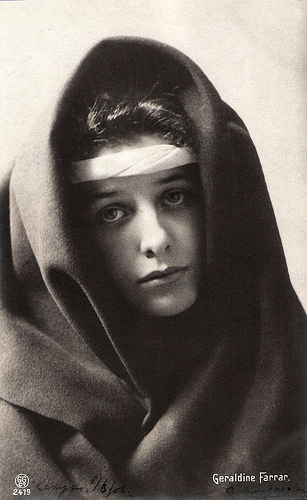
German postcard by G.G. & Co., no. 2419.
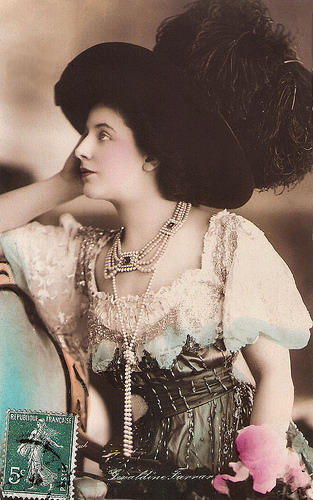
French postcard.
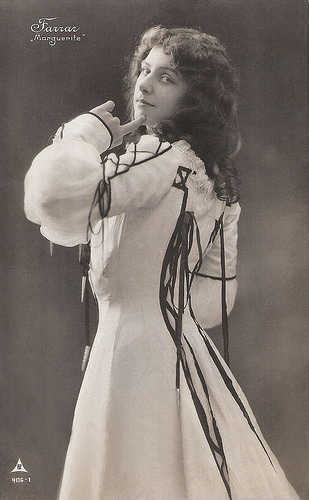
German postcard by PH, no. 4116/1. Geraldine Farrar as Marguerite in Charles Gounod's opera Faust.
Gerry-flappers
Alice Geraldine Farrar was born in Melrose, Massachusetts, in 1882. She was the daughter of baseball player Sidney Farrar, and his wife, Henrietta Barnes. At 5 she began studying music in Boston and by 14 was giving recitals. Later she studied voice with the American soprano Emma Thursby in New York City, in Paris, and finally with the Italian baritone Francesco Graziani in Berlin.
In 1901, Farrar created a sensation at the Berlin Hofoper with her debut as Marguerite in Charles Gounod's Faust. She remained with the company for three years, during which time she continued her studies with legendary Wagnerian soprano Lilli Lehmann. Farrar appeared in the title roles of Ambroise Thomas' Mignon and Jules Massenet's Manon, as well as Juliette in Charles Gounod's Roméo et Juliette.
Her admirers in Berlin included Crown Prince Wilhelm of Germany, with whom she is believed to have had a relationship beginning in 1903. This Berlin period was interspersed with three seasons with the Monte Carlo Opera. Highlights were Pietro Mascagni's Amica (1905), and Giuseppe Verdi's Rigoletto (1906) in which she appeared with Enrico Caruso.
In 1906, she also made her debut at the New York Metropolitan Opera in Romeo et Juliette. The success placed her on a plateau with Caruso as a box-office magnet. The next year, she got raves for her performance as Cio-Cio-San in the Metropolitan premiere of Giacomo Puccini's Madama Butterfly in 1907.
Farrar remained a member of the company until her retirement in 1922, singing 29 roles there in 672 performances. She developed a great popular following, especially among New York's young female opera-goers, who were known as Gerry-flappers. Farrar created the title roles in Puccini's Suor Angelica (1918), Umberto Giordano's Madame Sans-Gêne (1915), as well as the Goosegirl in Engelbert Humperdinck's Königskinder (1910), for which Farrar trained her own flock of geese. According to a New York Tribune review of the first performance, "at the close of the opera Miss Farrar caused 'much amusement' by appearing before the curtain with a live goose under her arm."
Her biographer Elizabeth Nash: “Unlike most of the famous bel canto singers of the past who sacrificed dramatic action to tonal perfection, she was more interested in the emotional than in the purely lyrical aspects of her roles.”
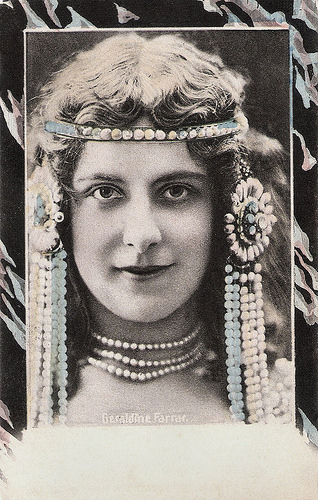
German postcard by K.V.i.B., Dess, no. 1016.
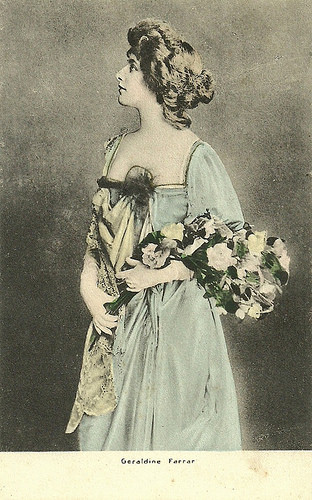
German postcard by K.V.i.B. 12. Dess., no. 4017.
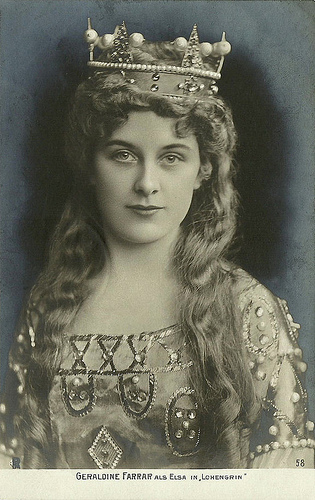
Vintage postcard, no. 58. Photo: Geraldine Farrar as Elsa in Lohengrin. Collection: Didier Hanson.
Cecil B. De Mille
Geraldine Farrar recorded extensively for the Victor Talking Machine Company and was often featured prominently in that firm's advertisements. She was one of the first performers to make a radio broadcast, in a 1907 publicity event singing over Lee De Forest's experimental AM radio transmitter in New York City.
She also starred in more than a dozen silent films from 1915 to 1920, which were filmed between opera seasons. Farrar made her debut with the title role in Cecil B. De Mille's Carmen (1915), based on the novella Carmen by Prosper Mérimée. For her role as the seductive gypsy girl she was extensively praised. For her performance, she came in fourth place in the 1916 Screen Masterpiece contest held by Motion Picture Magazine, ahead of any other actress.
DeMille directed her next in the silent romantic drama Temptation (Cecil B. DeMille, 1915), also with Theodore Roberts, and in the drama Maria Rosa (Cecil B. DeMille, 1916) with Wallace Reid.
Another notable screen role was as Joan of Arc in Joan the Woman (1917). This was Cecil DeMille's first historical drama. The screenplay is based on Friedrich Schiller's 1801 play Die Jungfrau von Orleans (The Maid of Orleans).
She next played the daughter of an Aztec king in the silent romance The Woman God Forgot (Cecil B. DeMille, 1917). In the film she falls in love with a Spanish captain (Wallace Reid) whose army has come to convert the Aztecs to Christianity. Her last film for Paramount Pictures was the romance The Devil-Stone (Cecil B. DeMille, 1917), again with Wallace Reid. The film had sequences filmed in the Handschiegl Color Process, but only two of six reels are known to survive.
For Goldwyn Pictures she appeared in such films as The Turn of the Wheel (Reginald Barker, 1918) with Herbert Rawlinson and Percy Marmont, the Western The Hell Cat (Reginald Barker, 1918), Shadows (Reginald Barker, 1918) and the melodrama The Stronger Vow (Reginald Barker, 1919), the latter three with Milton Sills. All four films are considered lost.
She co-starred with her husband Lou Tellegen in the dramas The World and Its Woman (Frank Lloyd, 1919), Flame of the Desert (Reginald Barker, 1919), and The Woman and the Puppet (Reginald Barker, 1920). Her final film was the silent drama The Riddle: Woman (Edward José, 1920), in which her co-star was Montagu Love.
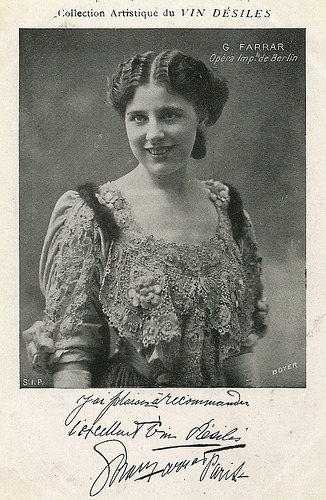
French postcard. Publicity for Vins Désiles. Photo SIP, Boyer. G. Farrar de l'Opéra Impéraile de Berlin. Caption: J'ai plaisir à recommander l'excellent Vin Désiles (I enjoy recommending the excellent Vin Désiles).
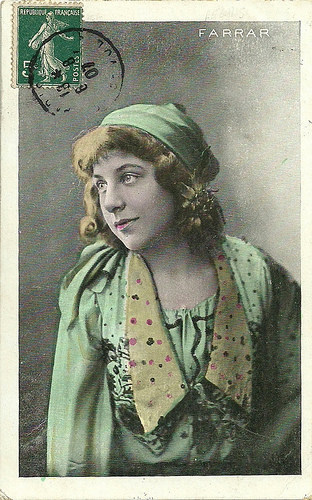
French postcard. Editor unknown. Postcard sent in 1907. Geraldine Farrar in the opera Mignon.
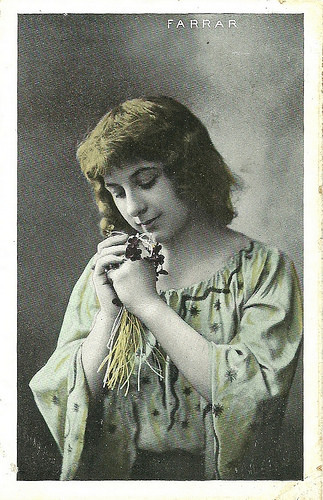
French postcard.
A messy and very public divorce
Geraldine Farrar had a seven-year love affair with the Italian conductor Arturo Toscanini. It was rumoured that she gave him an ultimatum that he must choose either her or his wife and children in Italy. It resulted in Toscanini's abrupt resignation as principal conductor of the Metropolitan Opera in 1915.
Farrar was close friends with the star tenor Enrico Caruso and there has been speculation that they too had a love affair, but no conclusive evidence of this has surfaced.
In 1916, she married Dutch film actor Lou Tellegen . Their marriage was the source of considerable scandal, and it ended, as a result of her husband's numerous affairs, in a messy and very public divorce in 1923. The circumstances of the divorce were brought again to public recollection by Tellegen's bizarre 1934 suicide in Hollywood. When told of her ex-husband's death, she replied "Why should that interest me?"
Farrar retired from opera in 1922 at the age of 40. Her final performance was as Ruggero Leoncavallo's Zazà. By this stage, her voice was in premature decline due to overwork. Farrar quickly transitioned into concert recitals, and was signed within several weeks of announcing her opera retirement to an appearance at Hershey Park on Memorial Day 1922.
She continued to make recordings and give recitals throughout the 1920s and was briefly the intermission commentator for the Metropolitan Opera radio broadcasts during the 1934–1935 season. Her rather bizarre autobiography, Such Sweet Compulsion (1938), was written in alternating chapters purporting to be her own words and those of her mother, with Mrs. Farrar rather floridly recounting her daughter's many accomplishments.
In 1967, Geraldine Farrar died in Ridgefield, Connecticut of heart disease aged 85, and was buried in Kensico Cemetery in Valhalla, New York. She had no children.
Recently I read an excellent biographical novel about Farrar and her great love Lou Tellegen by Dutch author Susan Smit, De eerste vrouw (The first woman). Hopefully there will be a translation soon. Anyway highly recommended.
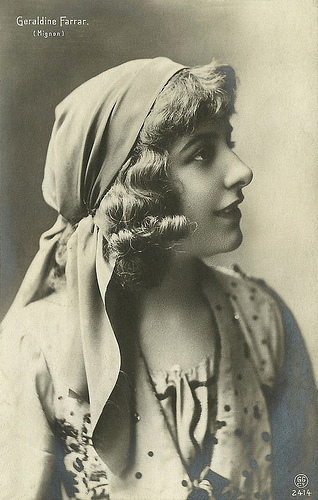
German postcard by G.G. & Co., no. 2414. Photo: publicity still for Mignon. Collection: Didier Hanson.
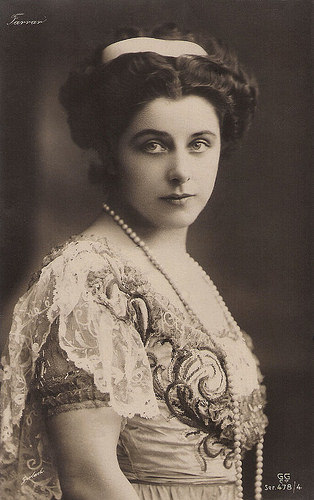
German postcard G.G. & Co., no. 478/4. Photo: Gerlach.
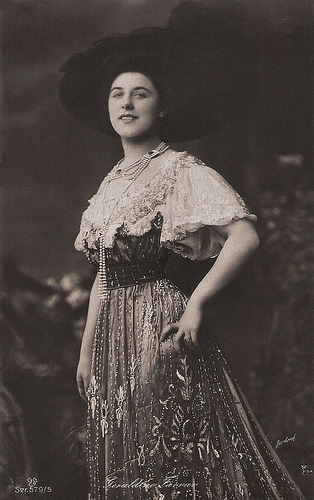
German postcard G.G. & Co., no. 579/5. Photo: Gerlach.
Sources: Andrea Suhm-Binder (Cantabile subito), Bob Hufford (Find A Grave), Wikipedia and .

German postcard by G.G. & Co., no. 2419.

French postcard.

German postcard by PH, no. 4116/1. Geraldine Farrar as Marguerite in Charles Gounod's opera Faust.
Gerry-flappers
Alice Geraldine Farrar was born in Melrose, Massachusetts, in 1882. She was the daughter of baseball player Sidney Farrar, and his wife, Henrietta Barnes. At 5 she began studying music in Boston and by 14 was giving recitals. Later she studied voice with the American soprano Emma Thursby in New York City, in Paris, and finally with the Italian baritone Francesco Graziani in Berlin.
In 1901, Farrar created a sensation at the Berlin Hofoper with her debut as Marguerite in Charles Gounod's Faust. She remained with the company for three years, during which time she continued her studies with legendary Wagnerian soprano Lilli Lehmann. Farrar appeared in the title roles of Ambroise Thomas' Mignon and Jules Massenet's Manon, as well as Juliette in Charles Gounod's Roméo et Juliette.
Her admirers in Berlin included Crown Prince Wilhelm of Germany, with whom she is believed to have had a relationship beginning in 1903. This Berlin period was interspersed with three seasons with the Monte Carlo Opera. Highlights were Pietro Mascagni's Amica (1905), and Giuseppe Verdi's Rigoletto (1906) in which she appeared with Enrico Caruso.
In 1906, she also made her debut at the New York Metropolitan Opera in Romeo et Juliette. The success placed her on a plateau with Caruso as a box-office magnet. The next year, she got raves for her performance as Cio-Cio-San in the Metropolitan premiere of Giacomo Puccini's Madama Butterfly in 1907.
Farrar remained a member of the company until her retirement in 1922, singing 29 roles there in 672 performances. She developed a great popular following, especially among New York's young female opera-goers, who were known as Gerry-flappers. Farrar created the title roles in Puccini's Suor Angelica (1918), Umberto Giordano's Madame Sans-Gêne (1915), as well as the Goosegirl in Engelbert Humperdinck's Königskinder (1910), for which Farrar trained her own flock of geese. According to a New York Tribune review of the first performance, "at the close of the opera Miss Farrar caused 'much amusement' by appearing before the curtain with a live goose under her arm."
Her biographer Elizabeth Nash: “Unlike most of the famous bel canto singers of the past who sacrificed dramatic action to tonal perfection, she was more interested in the emotional than in the purely lyrical aspects of her roles.”

German postcard by K.V.i.B., Dess, no. 1016.

German postcard by K.V.i.B. 12. Dess., no. 4017.

Vintage postcard, no. 58. Photo: Geraldine Farrar as Elsa in Lohengrin. Collection: Didier Hanson.
Cecil B. De Mille
Geraldine Farrar recorded extensively for the Victor Talking Machine Company and was often featured prominently in that firm's advertisements. She was one of the first performers to make a radio broadcast, in a 1907 publicity event singing over Lee De Forest's experimental AM radio transmitter in New York City.
She also starred in more than a dozen silent films from 1915 to 1920, which were filmed between opera seasons. Farrar made her debut with the title role in Cecil B. De Mille's Carmen (1915), based on the novella Carmen by Prosper Mérimée. For her role as the seductive gypsy girl she was extensively praised. For her performance, she came in fourth place in the 1916 Screen Masterpiece contest held by Motion Picture Magazine, ahead of any other actress.
DeMille directed her next in the silent romantic drama Temptation (Cecil B. DeMille, 1915), also with Theodore Roberts, and in the drama Maria Rosa (Cecil B. DeMille, 1916) with Wallace Reid.
Another notable screen role was as Joan of Arc in Joan the Woman (1917). This was Cecil DeMille's first historical drama. The screenplay is based on Friedrich Schiller's 1801 play Die Jungfrau von Orleans (The Maid of Orleans).
She next played the daughter of an Aztec king in the silent romance The Woman God Forgot (Cecil B. DeMille, 1917). In the film she falls in love with a Spanish captain (Wallace Reid) whose army has come to convert the Aztecs to Christianity. Her last film for Paramount Pictures was the romance The Devil-Stone (Cecil B. DeMille, 1917), again with Wallace Reid. The film had sequences filmed in the Handschiegl Color Process, but only two of six reels are known to survive.
For Goldwyn Pictures she appeared in such films as The Turn of the Wheel (Reginald Barker, 1918) with Herbert Rawlinson and Percy Marmont, the Western The Hell Cat (Reginald Barker, 1918), Shadows (Reginald Barker, 1918) and the melodrama The Stronger Vow (Reginald Barker, 1919), the latter three with Milton Sills. All four films are considered lost.
She co-starred with her husband Lou Tellegen in the dramas The World and Its Woman (Frank Lloyd, 1919), Flame of the Desert (Reginald Barker, 1919), and The Woman and the Puppet (Reginald Barker, 1920). Her final film was the silent drama The Riddle: Woman (Edward José, 1920), in which her co-star was Montagu Love.

French postcard. Publicity for Vins Désiles. Photo SIP, Boyer. G. Farrar de l'Opéra Impéraile de Berlin. Caption: J'ai plaisir à recommander l'excellent Vin Désiles (I enjoy recommending the excellent Vin Désiles).

French postcard. Editor unknown. Postcard sent in 1907. Geraldine Farrar in the opera Mignon.

French postcard.
A messy and very public divorce
Geraldine Farrar had a seven-year love affair with the Italian conductor Arturo Toscanini. It was rumoured that she gave him an ultimatum that he must choose either her or his wife and children in Italy. It resulted in Toscanini's abrupt resignation as principal conductor of the Metropolitan Opera in 1915.
Farrar was close friends with the star tenor Enrico Caruso and there has been speculation that they too had a love affair, but no conclusive evidence of this has surfaced.
In 1916, she married Dutch film actor Lou Tellegen . Their marriage was the source of considerable scandal, and it ended, as a result of her husband's numerous affairs, in a messy and very public divorce in 1923. The circumstances of the divorce were brought again to public recollection by Tellegen's bizarre 1934 suicide in Hollywood. When told of her ex-husband's death, she replied "Why should that interest me?"
Farrar retired from opera in 1922 at the age of 40. Her final performance was as Ruggero Leoncavallo's Zazà. By this stage, her voice was in premature decline due to overwork. Farrar quickly transitioned into concert recitals, and was signed within several weeks of announcing her opera retirement to an appearance at Hershey Park on Memorial Day 1922.
She continued to make recordings and give recitals throughout the 1920s and was briefly the intermission commentator for the Metropolitan Opera radio broadcasts during the 1934–1935 season. Her rather bizarre autobiography, Such Sweet Compulsion (1938), was written in alternating chapters purporting to be her own words and those of her mother, with Mrs. Farrar rather floridly recounting her daughter's many accomplishments.
In 1967, Geraldine Farrar died in Ridgefield, Connecticut of heart disease aged 85, and was buried in Kensico Cemetery in Valhalla, New York. She had no children.
Recently I read an excellent biographical novel about Farrar and her great love Lou Tellegen by Dutch author Susan Smit, De eerste vrouw (The first woman). Hopefully there will be a translation soon. Anyway highly recommended.

German postcard by G.G. & Co., no. 2414. Photo: publicity still for Mignon. Collection: Didier Hanson.

German postcard G.G. & Co., no. 478/4. Photo: Gerlach.

German postcard G.G. & Co., no. 579/5. Photo: Gerlach.
Sources: Andrea Suhm-Binder (Cantabile subito), Bob Hufford (Find A Grave), Wikipedia and .
Published on May 21, 2017 22:00
May 20, 2017
Paul Morgan
Austrian actor Paul Morgan (1886-1938) was one of the great theatre stars of the Weimar republic. He co-founded the illustrious Berlin cabaret Kadeko and made more than 100 films. In the 1930s Morgan refused to leave his homeland until it was too late. Arrested in March 1938, he died in Buchenwald concentration camp just months later.
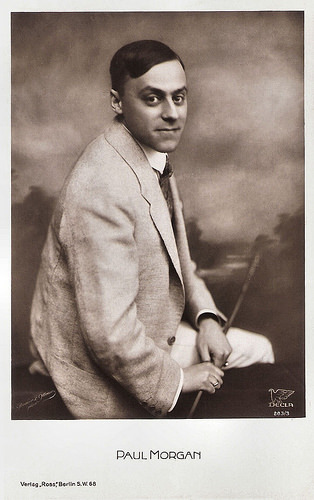
German postcard by Ross Verlag, Berlin, no. 283/3, 1919-1924. Photo: Decla. We could not identify the signature of the photographer. Rischke & Marby maybe?

Dutch postcard by JosPe, Arnhem, no. 54. Photo: Metro Goldwyn Mayer (MGM).
Simplicissimus
Paul Morgan was born as Georg Paul Morgenstern in 1886 in Vienna to an Austrian Jewish lawyer Gustav Morgenstern and his wife Clementine Morgenstern. He had a brother, Ernst Morgan, who would become an actor too. Like his parents Paul was baptised and raised Catholic.
Since childhood Paul wanted to pursue a life on the stage. Morgan studied theatre at the k.k. Akademie für Musik und darstellende Kunst, and he made his stage debut at the Theater in der Josefstadt. He performed in small theatres and cabarets.
In 1910 he made his film debut in the short La Miniature/The Miniature (Michel Carré, 1910) with Harry Baur . During the war he managed to avoid the draft due to his flat feet; and got his first big break at the cabaret Simplicissimus (Simpl) in 1914. He also appeared at Rosa Valetti's Kabarett Größenwahn. In 1917 he got an engagement at the Lessingtheater in Berlin.
After the First World War he had a successful film career. To his early silent films belong Die Puppe/The Doll (Ernst Lubitsch, 1919) with Ossi Oswalda , Die Reise um die Erde in 80 Tagen/Around the World in 80 Days (Richard Oswald, 1919) as well as Fritz Lang's successful productions Halbblut/The Half-Caste (1919) and Die Spinnen/The Spiders (1919-1920) with Carl de Vogt and Ressel Orla .
By the early 1920s, Morgan had become a star actor, singer and writer. Along with Kurt Robitschek and Max Hansen , he opened the Kabarett der Komiker (in short Kadeko) in 1924 in Berlin. The cabaret was an innovative combination of variety show and intimate theatre, and became one of the central comedy stages of Europe.
In the 1920s he also acted in very successful films, including Kurfürstendamm (Richard Oswald, 1920) with Conrad Veidt and Asta Nielsen , Vier um die Frau/Four Around a Woman (Fritz Lang, 1921), Die Brüder Schellenberg/The Brothers Schellenberg (Karl Grune, 1926) starring Conrad Veidt , and the Arthur Schnitzler adaptation Fräulein Else/Miss Else (Paul Czinner, 1929) with Elisabeth Bergner .
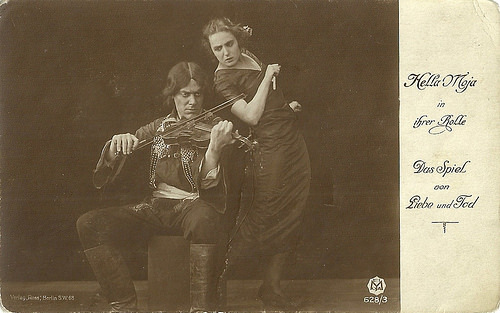
German postcard by Ross Verlag, no 628/3. Photo: Hella Moja-Film. Hella Moja and probably Paul Morgan in Das Spiel von Liebe und Tod/The Game of Love and Death (Urban Gad, 1919).
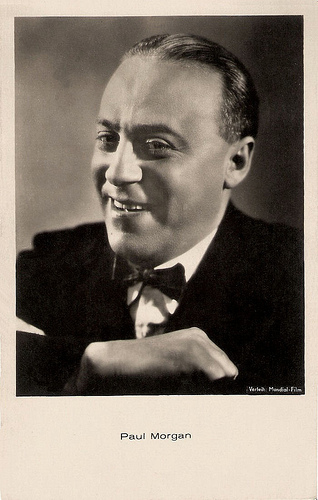
German postcard by Iris Verlag, no. 6387. Photo: Verleih Mondial-Film.
Kabarett der Komiker
In the late 1920s, Kadeko moved to a large new theatre in the centre of Berlin and expanded it’s scope, including guest appearances by famed international stars. The popularity of Paul Morgan increased.
He played in numerous films like Nur Du/Only You (Hermann Feiner, Willi Wolff, 1930), the popular operetta Zwei Herzen im Dreiviertel-Takt/Two Hearts in Waltz Time (Géza von Bolváry, 1930) with Willi Forst , and the comedy Ich und die Kaiserin/Me and the Empress (Friedrich Holländer, 1933) starring Lilian Harvey .
Morgan also made a name as an libretto author for musicals like Axel vor des Himmels Tor (Axel before Heaven's Door), with which Zarah Leander launched her career.
In 1930, the cabaret was blacklisted by several newspapers and the SA physically invaded the theatre during an anti-Hitler satire. Morgan decided to leave Germany and went to Hollywood for nine months to make German language versions of Hollywood films for MGM including Casanova wider Willen/Casanova Against His Will (Edward Brophy, 1931) with Buster Keaton .
He tried out the cabaret scene in Switzerland and appeared shortly at Erika Mann's Pfeffermühle, but ultimately he ended up back in Austria. Although he found it difficult to support himself in the increasingly reactionary Vienna, and he played only a small part in the film Katharina, die Letzte/Catherine the Last (Hermann Kosterlitz/Henry Koster, 1936) starring Franciska Gaal .
He did not want to leave, hoping, like so many, to ride out what was thought to be a temporary right-wing government. Just a few days after the Anschluss of Austria in 1938, Paul Morgan was arrested, and deported to concentration camp Dachau. The Gestapo specified as the motive that Paul Morgan was in possession of a letter of politician Gustav Stresemann (the letter was old; his Jewish roots were the real reason).
Soon thereafter he was transported to Buchenwald, where he died on 10 December 1938 because of pneumonia he got during an inhuman punishment drill in one of the coldest winters in Europe ever. Paul Morgan was 52. He was married to Josefine Lederer.
Recorded sketch and song of Paul Morgan and Max Hansen. Source: Plattensammler1988 (YouTube).
Sources: World ORT, Thomas Staedeli (Cyranos), Österreichisches Kabarettarchiv (German), Wikipedia (German) and .

German postcard by Ross Verlag, Berlin, no. 283/3, 1919-1924. Photo: Decla. We could not identify the signature of the photographer. Rischke & Marby maybe?

Dutch postcard by JosPe, Arnhem, no. 54. Photo: Metro Goldwyn Mayer (MGM).
Simplicissimus
Paul Morgan was born as Georg Paul Morgenstern in 1886 in Vienna to an Austrian Jewish lawyer Gustav Morgenstern and his wife Clementine Morgenstern. He had a brother, Ernst Morgan, who would become an actor too. Like his parents Paul was baptised and raised Catholic.
Since childhood Paul wanted to pursue a life on the stage. Morgan studied theatre at the k.k. Akademie für Musik und darstellende Kunst, and he made his stage debut at the Theater in der Josefstadt. He performed in small theatres and cabarets.
In 1910 he made his film debut in the short La Miniature/The Miniature (Michel Carré, 1910) with Harry Baur . During the war he managed to avoid the draft due to his flat feet; and got his first big break at the cabaret Simplicissimus (Simpl) in 1914. He also appeared at Rosa Valetti's Kabarett Größenwahn. In 1917 he got an engagement at the Lessingtheater in Berlin.
After the First World War he had a successful film career. To his early silent films belong Die Puppe/The Doll (Ernst Lubitsch, 1919) with Ossi Oswalda , Die Reise um die Erde in 80 Tagen/Around the World in 80 Days (Richard Oswald, 1919) as well as Fritz Lang's successful productions Halbblut/The Half-Caste (1919) and Die Spinnen/The Spiders (1919-1920) with Carl de Vogt and Ressel Orla .
By the early 1920s, Morgan had become a star actor, singer and writer. Along with Kurt Robitschek and Max Hansen , he opened the Kabarett der Komiker (in short Kadeko) in 1924 in Berlin. The cabaret was an innovative combination of variety show and intimate theatre, and became one of the central comedy stages of Europe.
In the 1920s he also acted in very successful films, including Kurfürstendamm (Richard Oswald, 1920) with Conrad Veidt and Asta Nielsen , Vier um die Frau/Four Around a Woman (Fritz Lang, 1921), Die Brüder Schellenberg/The Brothers Schellenberg (Karl Grune, 1926) starring Conrad Veidt , and the Arthur Schnitzler adaptation Fräulein Else/Miss Else (Paul Czinner, 1929) with Elisabeth Bergner .

German postcard by Ross Verlag, no 628/3. Photo: Hella Moja-Film. Hella Moja and probably Paul Morgan in Das Spiel von Liebe und Tod/The Game of Love and Death (Urban Gad, 1919).

German postcard by Iris Verlag, no. 6387. Photo: Verleih Mondial-Film.
Kabarett der Komiker
In the late 1920s, Kadeko moved to a large new theatre in the centre of Berlin and expanded it’s scope, including guest appearances by famed international stars. The popularity of Paul Morgan increased.
He played in numerous films like Nur Du/Only You (Hermann Feiner, Willi Wolff, 1930), the popular operetta Zwei Herzen im Dreiviertel-Takt/Two Hearts in Waltz Time (Géza von Bolváry, 1930) with Willi Forst , and the comedy Ich und die Kaiserin/Me and the Empress (Friedrich Holländer, 1933) starring Lilian Harvey .
Morgan also made a name as an libretto author for musicals like Axel vor des Himmels Tor (Axel before Heaven's Door), with which Zarah Leander launched her career.
In 1930, the cabaret was blacklisted by several newspapers and the SA physically invaded the theatre during an anti-Hitler satire. Morgan decided to leave Germany and went to Hollywood for nine months to make German language versions of Hollywood films for MGM including Casanova wider Willen/Casanova Against His Will (Edward Brophy, 1931) with Buster Keaton .
He tried out the cabaret scene in Switzerland and appeared shortly at Erika Mann's Pfeffermühle, but ultimately he ended up back in Austria. Although he found it difficult to support himself in the increasingly reactionary Vienna, and he played only a small part in the film Katharina, die Letzte/Catherine the Last (Hermann Kosterlitz/Henry Koster, 1936) starring Franciska Gaal .
He did not want to leave, hoping, like so many, to ride out what was thought to be a temporary right-wing government. Just a few days after the Anschluss of Austria in 1938, Paul Morgan was arrested, and deported to concentration camp Dachau. The Gestapo specified as the motive that Paul Morgan was in possession of a letter of politician Gustav Stresemann (the letter was old; his Jewish roots were the real reason).
Soon thereafter he was transported to Buchenwald, where he died on 10 December 1938 because of pneumonia he got during an inhuman punishment drill in one of the coldest winters in Europe ever. Paul Morgan was 52. He was married to Josefine Lederer.
Recorded sketch and song of Paul Morgan and Max Hansen. Source: Plattensammler1988 (YouTube).
Sources: World ORT, Thomas Staedeli (Cyranos), Österreichisches Kabarettarchiv (German), Wikipedia (German) and .
Published on May 20, 2017 22:00
May 19, 2017
Margarete Lanner
Margarete Lanner (1896–1981) was a German stage and film actress. She appeared in around 30 films during the silent era in a mixture of leading and supporting roles. She had a small part in Fritz Lang's classic Metropolis (1927).
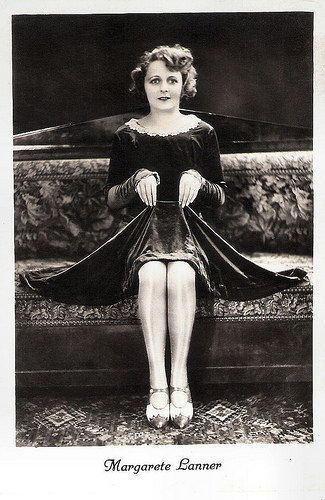
German postcard by H.C. Stöckel, Hannover-Linden for Bemberg. Caption: "Bemberg-Strümpfe, Bemberg-Seide, Herz und Sinn erfreuen beide!" (Bemberg stockings, Bemberg silk, delight both heart and sense!
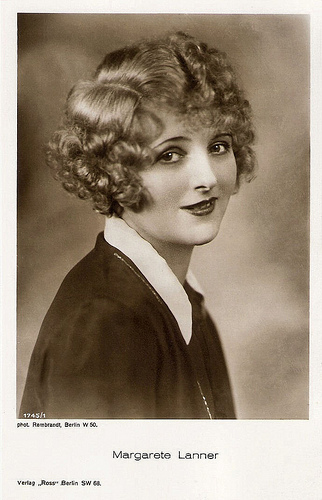
German postcard by Ross Verlag, no. 1745/1, 1927-1928. Photo: Rembrandt, Berlin.
The Bride of the Apaches
Margarete Lanner (also Marga Lanner) was born Margarethe Helene Langlotz in 1896 in Hamburg, Germany.
In 1917, she made her stage debut run in Hanau. In 1919, she returned to her birthplace of Hamburg, where she received her first film contract from the production company Vera-Filmwerke GmbH, which was based there.
She made her first film appearances in Brutal (Paul Otto, 1919) and Colombine (Martin Hartwig, 1919) with Emil Jannings . In the latter she played ‘the Bride of the Apaches’.
From then on, she easily found her way in the film business, and in the following years she played leading roles in a dozen films for Vera-Filmwerke. These include Der Staatsanwalt/The prosecutor (Paul Otto, 1920) with Werner Krauss , Das Geheimnis der grünen Villa/The Secret of the Green Villa (Philipp Lothar Mayring, 1921), Don Juan (Albert Heine, Robert Land, 1922) featuring Hans Adalbert Schlettow , Heines erste Liebe/Heine’s First Love (Eva Christa, 1922) and Die letzte Maske/The Final Mask (Emmerich Hanus, 1922).
In Sklaven der Rache/Slaves of Revenge (Philipp Lothar Mayring, 1921), she even played a double role as two sisters.
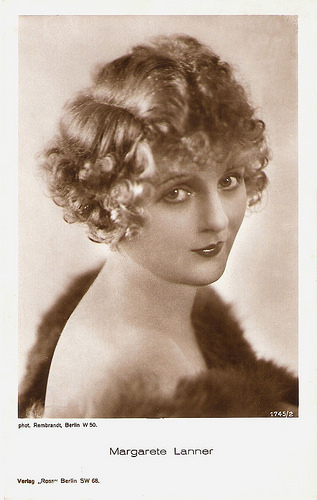
German postcard by Ross Verlag, no. 1745/2, 1927-1928. Photo: Rembrandt, Berlin.
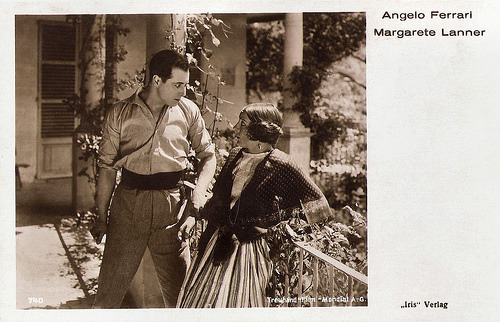
Austrian postcard by Iris Verlag, no. 740. Photo: Treuhand-Film / Mondial A.G. Publicity still for In Treue stark/In faithful strong (Heinrich Brandt, 1926) with Angelo Ferrari .
Leading roles in unspectacular productions
Margarete Lanner could count on a devoted regular audience, but Vera-Filmwerke stopped producing films in 1924. She moved to Berlin, where she continued her film career.
She played leading roles in unspectacular productions, such as the popular Ufa comedy Die zweite Mutter/The Second Mother (Heinrich Bolten-Baeckers, 1925) with Hans Mierendorff , and Des Lebens Würfelspiel/The Dice Game of Life (Heinz Paul, 1925), starring Frida Richard and Hella Moja .
Very spectacular is the expressionist Science Fiction masterpiece Metropolis (1927), Fritz Lang’s epic vision of a futuristic city where workers toil for their domineering overseers. However, Lanner’s part in the film was very small: she played a woman seen in a car and in the Eternal gardens.
The following year she made her final silent film, Das Fräulein von Kasse 12/The Woman from Till 12 (Erich Schönfelder, 1928), starring Werner Fuetterer and Dina Gralla . She retired from the film business for a longer time.
She married and became Margarete Gräfin Aichelburg. Only in 1936 she made a brief comeback with two films for Euphono-Film GmbH, Die Stunde der Versuchung/The Hour of Temptation (Paul Wegener, 1936) starring Gustav Fröhlich , and Ein Lied klagt an/A song laments (Georg Zoch, 1936) with Louis Graveure .
After that, she disappeared largely from the public eye. She returned to the theatre as an actress and singer under the name of Marga Lanner. She had a commitment to the Municipal Theater of Innsbruck in the 1938-1939 season. In 1940 she narrated the short Austrian documentary Kinderhände – Künstlerhände/Children 's Hands - Artists' Hands (Ulrich Kayser, 1940), her final film credit.
Margarete Lanner died in 1981 in Vienna, Austria. She was 84.
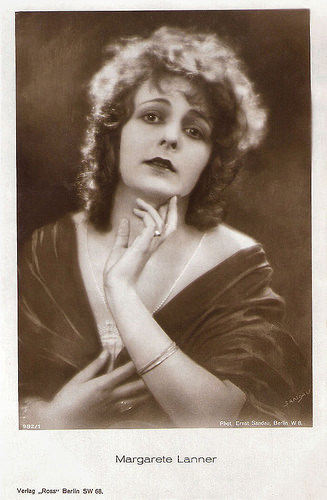
German postcard by Ross Verlag, no. 982/1, 1925-1926. Photo: Ernst Sandau, Berlin.
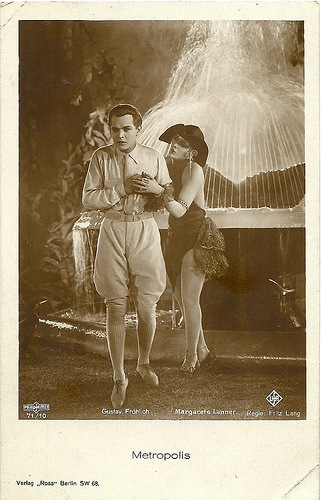
German postcard by Ross Verlag, Berlin, no. 71/10. Photo: Ufa / Parufamet. Publicity still for Metropolis (Fritz Lang, 1927) with Gustav Fröhlich . Collection: Didier Hanson.
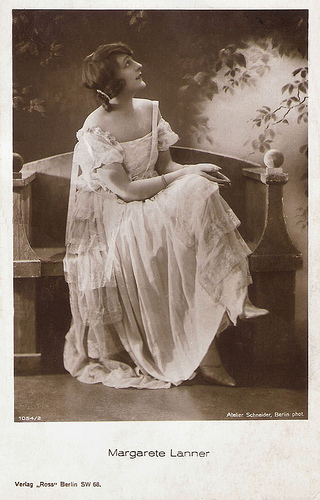
German postcard by Ross Verlag, no. 1054/2, 1927-1928. Photo: Atelier Schneider, Berlin.
Sources: Thomas Staedeli (Cyranos), BFI, Wikipedia (German and English) and .

German postcard by H.C. Stöckel, Hannover-Linden for Bemberg. Caption: "Bemberg-Strümpfe, Bemberg-Seide, Herz und Sinn erfreuen beide!" (Bemberg stockings, Bemberg silk, delight both heart and sense!

German postcard by Ross Verlag, no. 1745/1, 1927-1928. Photo: Rembrandt, Berlin.
The Bride of the Apaches
Margarete Lanner (also Marga Lanner) was born Margarethe Helene Langlotz in 1896 in Hamburg, Germany.
In 1917, she made her stage debut run in Hanau. In 1919, she returned to her birthplace of Hamburg, where she received her first film contract from the production company Vera-Filmwerke GmbH, which was based there.
She made her first film appearances in Brutal (Paul Otto, 1919) and Colombine (Martin Hartwig, 1919) with Emil Jannings . In the latter she played ‘the Bride of the Apaches’.
From then on, she easily found her way in the film business, and in the following years she played leading roles in a dozen films for Vera-Filmwerke. These include Der Staatsanwalt/The prosecutor (Paul Otto, 1920) with Werner Krauss , Das Geheimnis der grünen Villa/The Secret of the Green Villa (Philipp Lothar Mayring, 1921), Don Juan (Albert Heine, Robert Land, 1922) featuring Hans Adalbert Schlettow , Heines erste Liebe/Heine’s First Love (Eva Christa, 1922) and Die letzte Maske/The Final Mask (Emmerich Hanus, 1922).
In Sklaven der Rache/Slaves of Revenge (Philipp Lothar Mayring, 1921), she even played a double role as two sisters.

German postcard by Ross Verlag, no. 1745/2, 1927-1928. Photo: Rembrandt, Berlin.

Austrian postcard by Iris Verlag, no. 740. Photo: Treuhand-Film / Mondial A.G. Publicity still for In Treue stark/In faithful strong (Heinrich Brandt, 1926) with Angelo Ferrari .
Leading roles in unspectacular productions
Margarete Lanner could count on a devoted regular audience, but Vera-Filmwerke stopped producing films in 1924. She moved to Berlin, where she continued her film career.
She played leading roles in unspectacular productions, such as the popular Ufa comedy Die zweite Mutter/The Second Mother (Heinrich Bolten-Baeckers, 1925) with Hans Mierendorff , and Des Lebens Würfelspiel/The Dice Game of Life (Heinz Paul, 1925), starring Frida Richard and Hella Moja .
Very spectacular is the expressionist Science Fiction masterpiece Metropolis (1927), Fritz Lang’s epic vision of a futuristic city where workers toil for their domineering overseers. However, Lanner’s part in the film was very small: she played a woman seen in a car and in the Eternal gardens.
The following year she made her final silent film, Das Fräulein von Kasse 12/The Woman from Till 12 (Erich Schönfelder, 1928), starring Werner Fuetterer and Dina Gralla . She retired from the film business for a longer time.
She married and became Margarete Gräfin Aichelburg. Only in 1936 she made a brief comeback with two films for Euphono-Film GmbH, Die Stunde der Versuchung/The Hour of Temptation (Paul Wegener, 1936) starring Gustav Fröhlich , and Ein Lied klagt an/A song laments (Georg Zoch, 1936) with Louis Graveure .
After that, she disappeared largely from the public eye. She returned to the theatre as an actress and singer under the name of Marga Lanner. She had a commitment to the Municipal Theater of Innsbruck in the 1938-1939 season. In 1940 she narrated the short Austrian documentary Kinderhände – Künstlerhände/Children 's Hands - Artists' Hands (Ulrich Kayser, 1940), her final film credit.
Margarete Lanner died in 1981 in Vienna, Austria. She was 84.

German postcard by Ross Verlag, no. 982/1, 1925-1926. Photo: Ernst Sandau, Berlin.

German postcard by Ross Verlag, Berlin, no. 71/10. Photo: Ufa / Parufamet. Publicity still for Metropolis (Fritz Lang, 1927) with Gustav Fröhlich . Collection: Didier Hanson.

German postcard by Ross Verlag, no. 1054/2, 1927-1928. Photo: Atelier Schneider, Berlin.
Sources: Thomas Staedeli (Cyranos), BFI, Wikipedia (German and English) and .
Published on May 19, 2017 22:00
May 18, 2017
Maria Corda
Hungarian Maria Corda (1898-1975) was an immensely popular star of the silent cinema of Austria and Germany. The pretty, blonde actress was a queen of the popular epic spectacles of the 1920s, which were often directed by her husband, Alexander Korda.
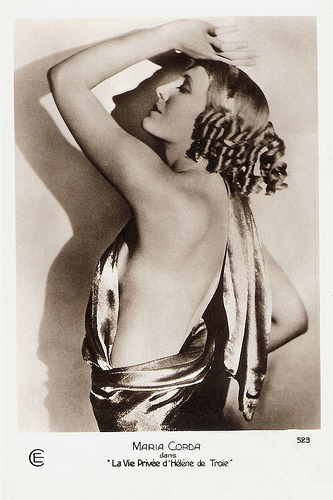
French postcard by Editions Cinémagazine, no. 523. Publicity still for The Private Life of Helen of Troy (Alexander Korda, 1927).
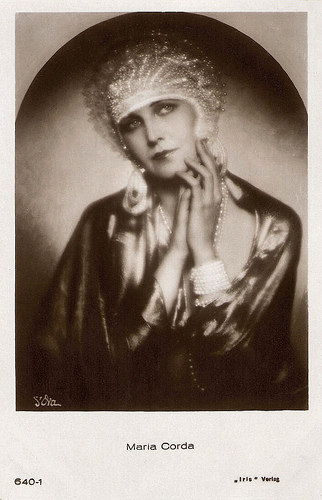
Austrian postcard by Iris Verlag, no. 640-1. Photo: d'Ora.
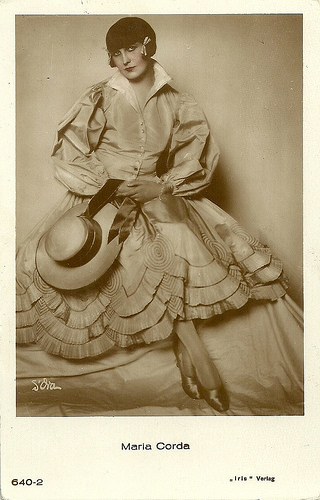
Austrian postcard by Iris Verlag, no. 640-2. Photo d'Ora.
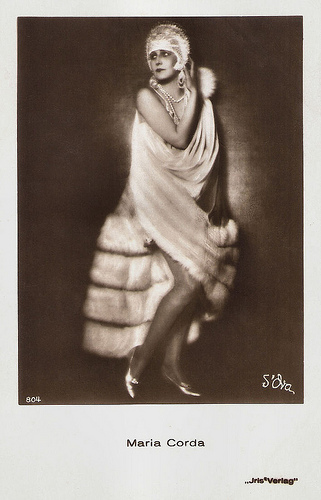
Austrian postcard by Iris Verlag, no. 804. Photo: d'Ora.
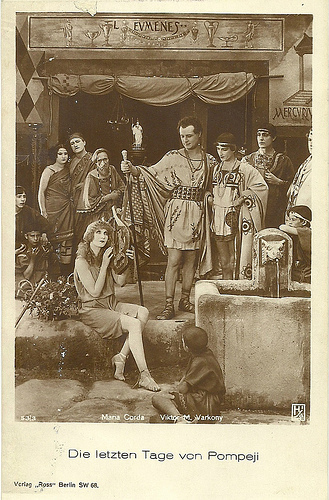
German postcard by Ross Verlag, no. 53/3. Photo: Hisa. Publicity still for Gli ultimi giorni di Pompei/The Last Days of Pompeii (Carmine Gallone, Amleto Palermi, 1926). Collection: Didier Hanson.
The Slave Queen
María Corda (sometimes spelled as Korda) was born as María Antónia Farkas in Déva, Hungary in 1898.
She began her acting career in the theatres of Budapest in the early days of World War I. Soon after Hungary became an independent state she began to work in the film industry as well.
As Antónia Farkas she made her first film appearance in Se ki, se be/Not In, or Out (Sándor Korda aka Alexander Korda, 1919). In 1919 she married her director, but she would always write her last name differently to differentiate herself from her husband.
He featured her in Fehér rózsa/The White Rose (Alexander Korda, 1919), Ave Caesar! (Alexander Korda, 1919) and A 111-es/Number 111 (Alexander Korda, 1919).
She followed Korda when he journeyed to Vienna to join the Sascha Film Company. There Korda made her a star of the European silent cinema.
Under his guidance she took part in epic films like Samson und Delila/Samson and Delilah (Alexander Korda, 1922) and Die Sklavenkönigin/The Slave Queen (Mihály Kertész aka Michael Curtiz, 1924).
Set in ancient Egypt, Die Sklavenkönigin recounts the oppression of the Jews under the despotic rule of Pharaoh Menapta. Against this backdrop is played the romantic story of Hebrew girl Merapi (Maria), the ‘Moon of Israel’, and Prince Seti ( Adelqui Migliar aka Adelqui Millar), heir to the Egyptian throne.
Die Sklavenkönigin was intended for an American release that same year, under the title Moon of Israel. That release was suppressed by Cecil B. DeMille, who worried that his own The Ten Commandments would be compared unfavourably. In 1927 Moon of Israel arrived in the American cinemas, director Michael Curtiz had been hired by Warner Bros., largely on the strength of this one film.
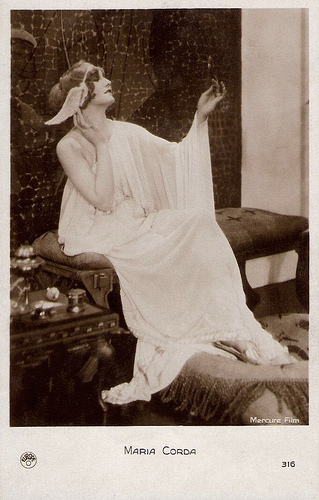
French postcard by Europe, no. 316. Photo: Mercure Film.
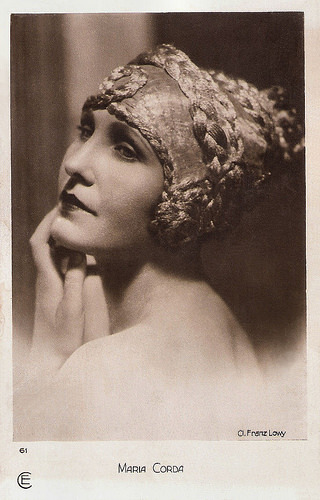
French postcard by Cinémagazine-Edition, no. 61. Photo: Franz Lowy.
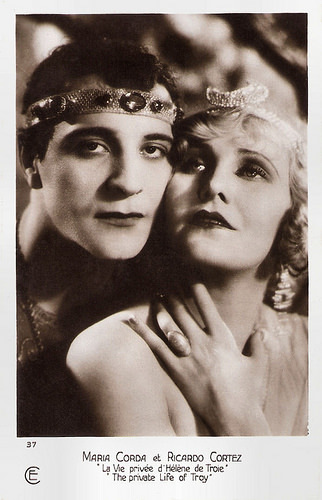
French postcard by Cinémagazine-Edition, no. 37. Photo: publicity still for The Private Life of Helen of Troy (Alexander Korda, 1927) with Ricardo Cortez.
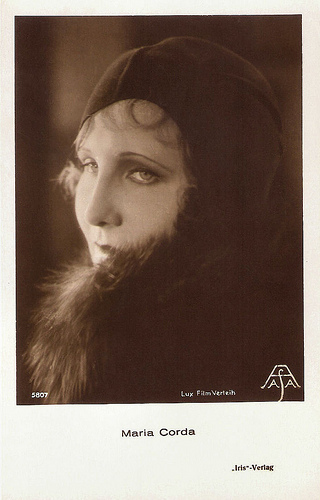
Austrian postcard by Iris Verlag, no. 5807. Photo: Lux Film Verleih / Aafa.
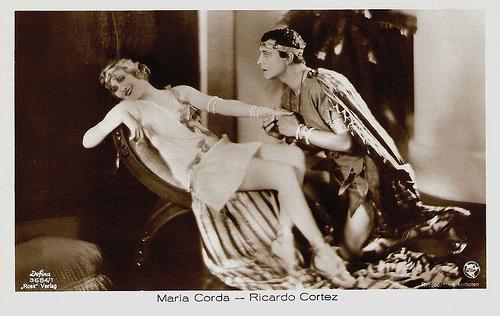
German postcard by Ross Verlag, no. 3684/1, 1928-1929. Photo: Defina. With Ricardo Cortez in The Private Life of Helen of Troy (Alexander Korda, 1927).
Box Office Queen
In the mid-1920s, Maria Corda had become a darling of the public and a sure guarantee for success at the box office. To her hits belong Das unbekannte Morgen/The Unknown Tomorrow (Alexander Korda, 1923) with Werner Krauss , Jedermanns Frau/Everybody's Woman (Alexander Korda, 1924), and Madame wünscht keine Kinder/Madame Doesn't Want Children (Alexander Korda, 1926) with Harry Liedtke .
Her popularity was so huge that Austrian investors refused their grant for the Italian film Gli ultimi giorni di Pompei/The Last Days of Pompeii (Carmine Gallone, Amleto Palermi, 1926) unless the leading part would be recast with Maria Corda. And of course that’s what finally happened.
Desperately seeking his independence, Alexander Korda moved to Berlin to form his own company Korda-Film, and Maria moved with him to the German capital. There Korda directed his wife in Eine DuBarry Von Heute/A Modern DuBarry (Alexander Korda, 1926).
Corda played Toinette, a saucy, somewhat amoral scullery maid. Bouncing from bed to bed, Toinette becomes the mistress of Count Martel ( Alfred Gerasch ) and, ultimately, the King of Andalia (Jean Bradin).
This final liaison very nearly topples the Andalian government, but Toinette manages to survive this ordeal without a hair out of place, though she does cry and cry a lot when things don't go her way. This film landed Korda his Hollywood contract, and he and Maria travelled to the US.
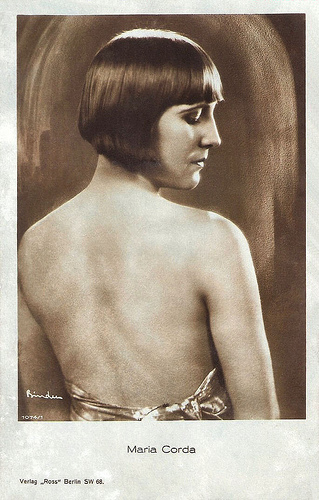
German postcard by Ross Verlag, no. 1074/1, 1927-1928. Photo: Alex Binder.
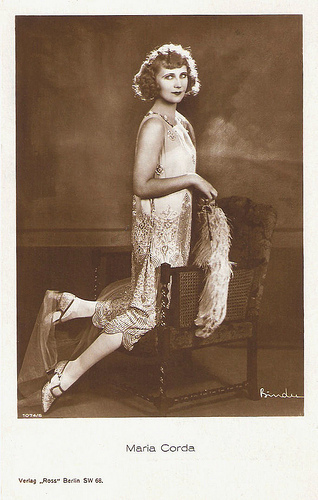
German postcard by Ross Verlag, no. 1074/6, 1927-1928. Photo: Alex Binder.
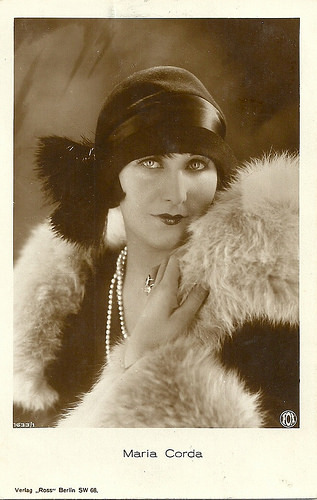
German postcard by Ross Verlag, no. 1633/1, 1927-1928. Photo: Fox.
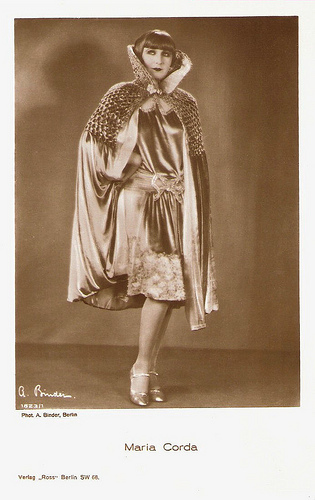
German postcard by Ross Verlag, no. 1823/1, 1927-1928. Photo: Alex Binder.
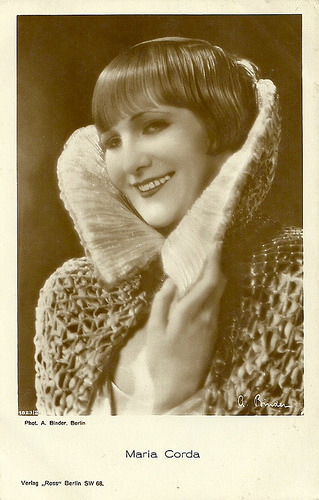
German postcard by Ross Verlag, no. 1823/2, 1927-1928. Photo: Alex Binder.
Oblivion
Maria Corda’s one truly successful Hollywood film performance was in The Private Life of Helen of Troy (Alexander Korda, 1927). Setting the standard for his later light-hearted biopics The Private Life of Henry VIII and Rembrandt, Korda steadfastly refused to take any of The Private Life of Helen of Troy seriously.
Maria Corda played the title character as a fetchingly underdressed coquette, oblivious to all the political turmoil she's causing when she allows the handsome Paris (Ricardo Cortez) to kidnap her. The film was nominated for an Academy Award in 1928, the year of the Awards' inception, in the category of Best Title Writing.
Other Hollywood productions with Corda like the early sound film Love and the Devil (Alexander Korda, 1929) enjoyed little success. She finished her Hollywood career when the sound came to stay, because her English was limited.
She returned to Europe where she appeared in the silent comedies Der moderne Casanova/A Modern Casanova (Max Obal, 1928) and Die Konkurrenz platzt/The competition bursts (Max Obal, Rudolf Walther-Fein, 1929), both opposite Harry Liedtke .
In Germany she made one more sound film: Rund um die Liebe/All around love (Oskar Kalbus, 1929) with Elisabeth Bergner . In 1930 Maria Corda divorced Alexander Korda and she would never make another film.
She moved to New York where she wrote novels. The formerly celebrated film goddess fell into oblivion. The later years of her life were spent in the vicinity of Geneva in Switzerland. Maria Corda died there in Thônex in 1976. She was 77.
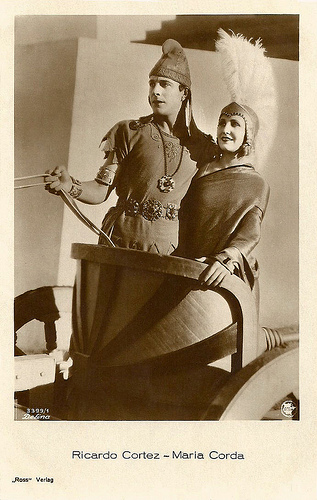
German postcard by Ross Verlag, no. 3399/1, 1928-1929. Photo: Defina. Publicity still of Maria Corda and Ricardo Cortez as Helena and Paris in The Private Life of Helen of Troy (Alexander Korda, 1927).
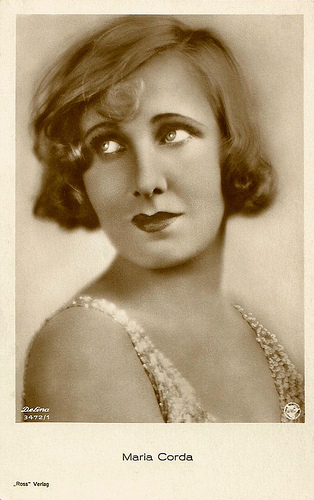
German postcard by Ross Verlag, no. 3472/1, 1928-1929. Photo: Defina.
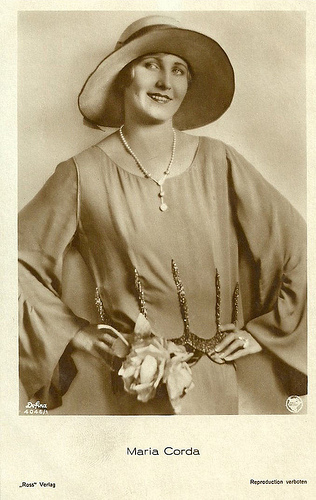
German postcard by Ross Verlag, no. 4046/1, 1929-1930. Photo: Defina.
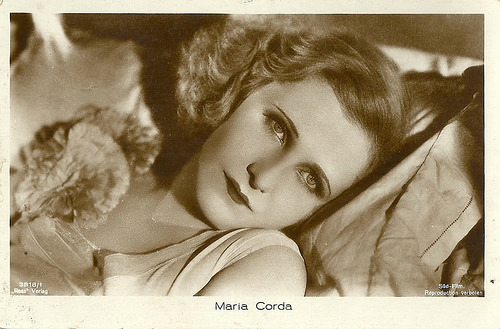
German postcard by Ross Verlag, no. 3818/1, 1928-1929. Photo: Süd-Film.
Sources: Thomas Staedeli (Cyranos), Hal Erickson (AllMovie), J. A. Aberdeen (Hollywood Renegades Archives), Allure, Wikipedia and .

French postcard by Editions Cinémagazine, no. 523. Publicity still for The Private Life of Helen of Troy (Alexander Korda, 1927).

Austrian postcard by Iris Verlag, no. 640-1. Photo: d'Ora.

Austrian postcard by Iris Verlag, no. 640-2. Photo d'Ora.

Austrian postcard by Iris Verlag, no. 804. Photo: d'Ora.

German postcard by Ross Verlag, no. 53/3. Photo: Hisa. Publicity still for Gli ultimi giorni di Pompei/The Last Days of Pompeii (Carmine Gallone, Amleto Palermi, 1926). Collection: Didier Hanson.
The Slave Queen
María Corda (sometimes spelled as Korda) was born as María Antónia Farkas in Déva, Hungary in 1898.
She began her acting career in the theatres of Budapest in the early days of World War I. Soon after Hungary became an independent state she began to work in the film industry as well.
As Antónia Farkas she made her first film appearance in Se ki, se be/Not In, or Out (Sándor Korda aka Alexander Korda, 1919). In 1919 she married her director, but she would always write her last name differently to differentiate herself from her husband.
He featured her in Fehér rózsa/The White Rose (Alexander Korda, 1919), Ave Caesar! (Alexander Korda, 1919) and A 111-es/Number 111 (Alexander Korda, 1919).
She followed Korda when he journeyed to Vienna to join the Sascha Film Company. There Korda made her a star of the European silent cinema.
Under his guidance she took part in epic films like Samson und Delila/Samson and Delilah (Alexander Korda, 1922) and Die Sklavenkönigin/The Slave Queen (Mihály Kertész aka Michael Curtiz, 1924).
Set in ancient Egypt, Die Sklavenkönigin recounts the oppression of the Jews under the despotic rule of Pharaoh Menapta. Against this backdrop is played the romantic story of Hebrew girl Merapi (Maria), the ‘Moon of Israel’, and Prince Seti ( Adelqui Migliar aka Adelqui Millar), heir to the Egyptian throne.
Die Sklavenkönigin was intended for an American release that same year, under the title Moon of Israel. That release was suppressed by Cecil B. DeMille, who worried that his own The Ten Commandments would be compared unfavourably. In 1927 Moon of Israel arrived in the American cinemas, director Michael Curtiz had been hired by Warner Bros., largely on the strength of this one film.

French postcard by Europe, no. 316. Photo: Mercure Film.

French postcard by Cinémagazine-Edition, no. 61. Photo: Franz Lowy.

French postcard by Cinémagazine-Edition, no. 37. Photo: publicity still for The Private Life of Helen of Troy (Alexander Korda, 1927) with Ricardo Cortez.

Austrian postcard by Iris Verlag, no. 5807. Photo: Lux Film Verleih / Aafa.

German postcard by Ross Verlag, no. 3684/1, 1928-1929. Photo: Defina. With Ricardo Cortez in The Private Life of Helen of Troy (Alexander Korda, 1927).
Box Office Queen
In the mid-1920s, Maria Corda had become a darling of the public and a sure guarantee for success at the box office. To her hits belong Das unbekannte Morgen/The Unknown Tomorrow (Alexander Korda, 1923) with Werner Krauss , Jedermanns Frau/Everybody's Woman (Alexander Korda, 1924), and Madame wünscht keine Kinder/Madame Doesn't Want Children (Alexander Korda, 1926) with Harry Liedtke .
Her popularity was so huge that Austrian investors refused their grant for the Italian film Gli ultimi giorni di Pompei/The Last Days of Pompeii (Carmine Gallone, Amleto Palermi, 1926) unless the leading part would be recast with Maria Corda. And of course that’s what finally happened.
Desperately seeking his independence, Alexander Korda moved to Berlin to form his own company Korda-Film, and Maria moved with him to the German capital. There Korda directed his wife in Eine DuBarry Von Heute/A Modern DuBarry (Alexander Korda, 1926).
Corda played Toinette, a saucy, somewhat amoral scullery maid. Bouncing from bed to bed, Toinette becomes the mistress of Count Martel ( Alfred Gerasch ) and, ultimately, the King of Andalia (Jean Bradin).
This final liaison very nearly topples the Andalian government, but Toinette manages to survive this ordeal without a hair out of place, though she does cry and cry a lot when things don't go her way. This film landed Korda his Hollywood contract, and he and Maria travelled to the US.

German postcard by Ross Verlag, no. 1074/1, 1927-1928. Photo: Alex Binder.

German postcard by Ross Verlag, no. 1074/6, 1927-1928. Photo: Alex Binder.

German postcard by Ross Verlag, no. 1633/1, 1927-1928. Photo: Fox.

German postcard by Ross Verlag, no. 1823/1, 1927-1928. Photo: Alex Binder.

German postcard by Ross Verlag, no. 1823/2, 1927-1928. Photo: Alex Binder.
Oblivion
Maria Corda’s one truly successful Hollywood film performance was in The Private Life of Helen of Troy (Alexander Korda, 1927). Setting the standard for his later light-hearted biopics The Private Life of Henry VIII and Rembrandt, Korda steadfastly refused to take any of The Private Life of Helen of Troy seriously.
Maria Corda played the title character as a fetchingly underdressed coquette, oblivious to all the political turmoil she's causing when she allows the handsome Paris (Ricardo Cortez) to kidnap her. The film was nominated for an Academy Award in 1928, the year of the Awards' inception, in the category of Best Title Writing.
Other Hollywood productions with Corda like the early sound film Love and the Devil (Alexander Korda, 1929) enjoyed little success. She finished her Hollywood career when the sound came to stay, because her English was limited.
She returned to Europe where she appeared in the silent comedies Der moderne Casanova/A Modern Casanova (Max Obal, 1928) and Die Konkurrenz platzt/The competition bursts (Max Obal, Rudolf Walther-Fein, 1929), both opposite Harry Liedtke .
In Germany she made one more sound film: Rund um die Liebe/All around love (Oskar Kalbus, 1929) with Elisabeth Bergner . In 1930 Maria Corda divorced Alexander Korda and she would never make another film.
She moved to New York where she wrote novels. The formerly celebrated film goddess fell into oblivion. The later years of her life were spent in the vicinity of Geneva in Switzerland. Maria Corda died there in Thônex in 1976. She was 77.

German postcard by Ross Verlag, no. 3399/1, 1928-1929. Photo: Defina. Publicity still of Maria Corda and Ricardo Cortez as Helena and Paris in The Private Life of Helen of Troy (Alexander Korda, 1927).

German postcard by Ross Verlag, no. 3472/1, 1928-1929. Photo: Defina.

German postcard by Ross Verlag, no. 4046/1, 1929-1930. Photo: Defina.

German postcard by Ross Verlag, no. 3818/1, 1928-1929. Photo: Süd-Film.
Sources: Thomas Staedeli (Cyranos), Hal Erickson (AllMovie), J. A. Aberdeen (Hollywood Renegades Archives), Allure, Wikipedia and .
Published on May 18, 2017 22:00
May 17, 2017
Die Sünde (1918)
German silent film star Ressel Orla (1889-1931) peaked in the late 1910s and early 1920s in early films by Fritz Lang and Ernst Lubitsch. With the drama Die Sünde/The Sin (Alwin Neuss, 1918) the Decla-Film-Gesellschaft, run by producer Erich Pommer, offered Orla her own series. The popular comedienne proved she also could handle dramatic roles.
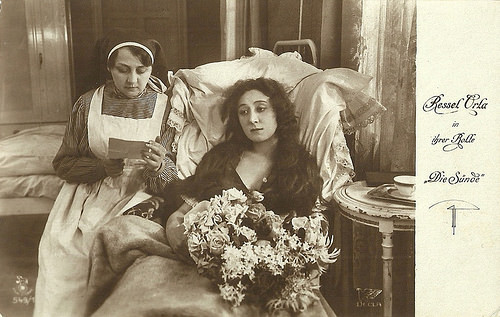
German postcard in the Film Sterne series by Rotophot, no. 549/1. Photo: Decla. Ressel Orla in Die Sünde/The Sin (Alwin Neuss, 1918).
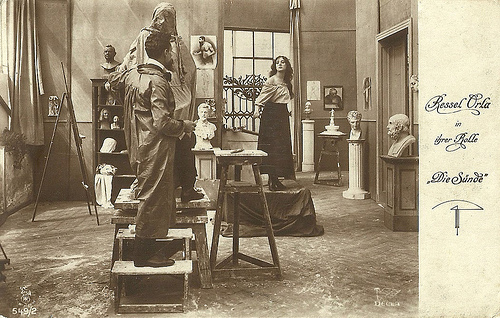
German postcard in the Film Sterne series by Rotophot, no. 549/2. Photo: Decla. Ressel Orla in Die Sünde/The Sin (Alwin Neuss, 1918).
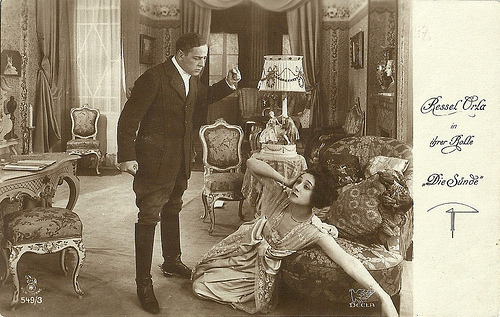
German postcard in the Film Sterne series by Rotophot, no. 549/3. Photo: Decla. Emil Birron and Ressel Orla in Die Sünde/The Sin (Alwin Neuss, 1918).
A ravishing, elementary force
Die Sünde/The Sin (1918) is directed by actor Alwin Neuss and produced by famous producer Erich Pommer for the Decla-Film-Gesellschaft, which he ran at the time.
It was the first of Ressel Orla 's own series, in which she was protagonist and which focused on highly dramatic plots. Before Die Sünde she had become popular as a comedienne. Her co-stars in Die Sünde were Emil Birron, Paul Rehkopf and Alwin Neuss .
The Berlin trade journal Lichtbild-Bühne (Bd. 11, Nr. 28, 13.07.1918, S. 72) raved about her: " Ressel Orla appears as the well-bred woman who knows to curb her temper, which yet explodes at moments and dominated everything around her. Here the fire of enthusiasm kindles which inspires.
Moreover, Ressel Orla brings along all external assets to awaken sympathy at her first appearance. Indeed, it seems possible that this sympathy towards such a thoroughbred talent maintains, even if the character to be represented is little sympathetic.
In Sünde Ressel Orla has first to play the young thing, who becomes an artist's model under the force of circumstances, in order to save her dying father. When she later stands alone in the world, she rises to happiness without suffering from her past.
But then the pride of the woman awakens in her, to whom only the right of her own ego applies. In these scenes full of fervour and passion Ressel Orla was of ravishing, elementary force."
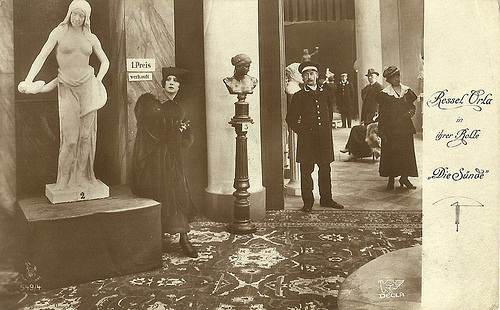
German postcard in the Film Sterne series by Rotophot, no. 549/4. Photo: Decla. Ressel Orla in Die Sünde/The Sin (Alwin Neuss, 1918).
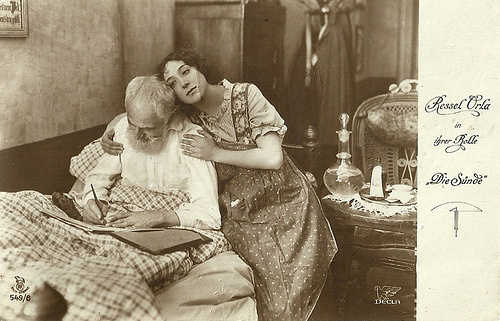
German postcard in the Film Sterne series by Rotophot, no. 549/6. Photo: Decla. Paul Rehkopf and Ressel Orla in Die Sünde/The Sin (Alwin Neuss, 1918).

Ressel Orla. German postcard in the Film Sterne series by Rotophot, no. 92/3. Photo: Karl Schenker, Berlin.
Sources: Stephanie d'Heil (Steffi-Line - German), Thomas Staedeli (Cyranos), Filmhistoriker.de, Wikipedia (English and German) and IMDb.

German postcard in the Film Sterne series by Rotophot, no. 549/1. Photo: Decla. Ressel Orla in Die Sünde/The Sin (Alwin Neuss, 1918).

German postcard in the Film Sterne series by Rotophot, no. 549/2. Photo: Decla. Ressel Orla in Die Sünde/The Sin (Alwin Neuss, 1918).

German postcard in the Film Sterne series by Rotophot, no. 549/3. Photo: Decla. Emil Birron and Ressel Orla in Die Sünde/The Sin (Alwin Neuss, 1918).
A ravishing, elementary force
Die Sünde/The Sin (1918) is directed by actor Alwin Neuss and produced by famous producer Erich Pommer for the Decla-Film-Gesellschaft, which he ran at the time.
It was the first of Ressel Orla 's own series, in which she was protagonist and which focused on highly dramatic plots. Before Die Sünde she had become popular as a comedienne. Her co-stars in Die Sünde were Emil Birron, Paul Rehkopf and Alwin Neuss .
The Berlin trade journal Lichtbild-Bühne (Bd. 11, Nr. 28, 13.07.1918, S. 72) raved about her: " Ressel Orla appears as the well-bred woman who knows to curb her temper, which yet explodes at moments and dominated everything around her. Here the fire of enthusiasm kindles which inspires.
Moreover, Ressel Orla brings along all external assets to awaken sympathy at her first appearance. Indeed, it seems possible that this sympathy towards such a thoroughbred talent maintains, even if the character to be represented is little sympathetic.
In Sünde Ressel Orla has first to play the young thing, who becomes an artist's model under the force of circumstances, in order to save her dying father. When she later stands alone in the world, she rises to happiness without suffering from her past.
But then the pride of the woman awakens in her, to whom only the right of her own ego applies. In these scenes full of fervour and passion Ressel Orla was of ravishing, elementary force."

German postcard in the Film Sterne series by Rotophot, no. 549/4. Photo: Decla. Ressel Orla in Die Sünde/The Sin (Alwin Neuss, 1918).

German postcard in the Film Sterne series by Rotophot, no. 549/6. Photo: Decla. Paul Rehkopf and Ressel Orla in Die Sünde/The Sin (Alwin Neuss, 1918).

Ressel Orla. German postcard in the Film Sterne series by Rotophot, no. 92/3. Photo: Karl Schenker, Berlin.
Sources: Stephanie d'Heil (Steffi-Line - German), Thomas Staedeli (Cyranos), Filmhistoriker.de, Wikipedia (English and German) and IMDb.
Published on May 17, 2017 22:00
May 16, 2017
Oleg Vidov (1943-2017)
Yesterday, 16 May 2017, Russian leading man Oleg Vidov passed away. In the former Soviet Union, the handsome actor was a sex symbol for his generation. Since 1961 he starred in some 50 films, and many are still played on Russian television today. The 73-year-old Vidov died of cancer in his new homeland, the U.S.
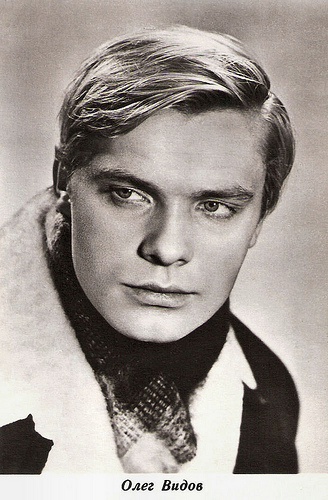
Russian postcard by Izdanije Byuro Propogandy Sovietskogo Kinoiskusstva, no. 4, 1973. This postcard was printed in an edition of 40,000 cards. Retail price: 8 Kop.
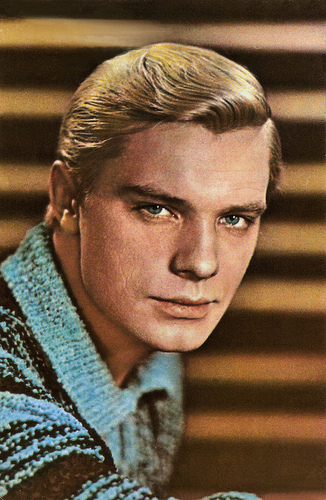
Russian postcard by Izdanije Byuro Propogandy Sovietskogo Kinoiskusstva, no. A 04747, 1968. This postcard was printed in an edition of 100.000 cards. Retail price: 8 Kop.
Bear Turned Man
Oleg Borisovich Vidov was born in Filimonki, a suburb of Moscow, USSR (now Russia) in 1943. His parents were Varvara Vidova, a teacher, and Boris Nikolaievich Garnevich, an economist. As a child he lived with his mother, who worked for the Soviet government in the field of education in Mongolia and East Germany. When his mother was sent to China on assignment, he went to live with his aunt Anuta in Kazakhstan. Eventually he moved with his mother and aunt to Moscow.
At 18, competing against hundreds of would-be actors, he was accepted to the acting department of the state film school VGIK. In 1961, he made his film debut with a bit part in the drama Друг мой, Колька!../Drug moy, Kolka!../My friend Kolka! (Aleksandr Mitta, Aleksei Saltykov, 1961). Eleanor Mannikka at AllMovie : “This was an unusual comedy for its day in the USSR. Put together by two graduate students in film, the story tweaks the establishment with some fairly sharp barbs. At the receiving end of the satire is the rigid, party-line, slogan-spouting school system and its load of propaganda.”
In 1964, the young actor played a bear-turned-man who falls in love with a princess in Обыкновенное чудо/Obyknovennoye chudo/An Ordinary Miracle (Erast Garin, 1964). This wonderful fairy love story was partly filmed in the Vorontsov Palace. Next, Vidov starred in Метель/Metel/The Blizzard (Vladimir Basov, 1964), based on a story by Alexander Pushkin.
He played a prince charming in the fairy tale Сказка о царе Салтане/Skazka o tsare Saltane/The Tale of Tsar Saltan (Aleksandr Ptushko, 1967) with Larisa Golubkina. In 1968, he went to Yugoslavia for the romance Ima ljubavi, nema ljubavi/There is love, no love (Nikola Rajic, 1968) with Olivera Katerina, and the war drama Uzrok smrti ne pominjati/Do Not Mention the Cause of Death (Jovan Zivanovic, 1968) starring Bekim Fehmiu.
Vidov also appeared in the Yugoslavian production Битка на Неретви/Bitka na Neretvi/Battle of Neretva (Veljko Bulajić, 1969) based on the true events of World War II. The Battle of the Neretva was due to a strategic plan for a combined Axis powers attack in 1943 against the Yugoslav Partisans. The plan was also known as the Fourth Enemy Offensive and occurred in the area of the Neretva river in Bosnia and Herzegovina.
Battle of Neretva was the most expensive film made in the SFR Yugoslavia. It was the first of the huge state-sponsored World War II film productions and had a staggering budget (somewhere between $4.5 million and $12 million) approved personally by Yugoslav president Josip Tito. In the cast were global stars like Sergei Bondarchuk (who had just won an Oscar for War and Peace), Yul Brynner , Franco Nero , Orson Welles , Hardy Krüger and Sylva Koscina . Battle of Neretva was nominated for the Academy Award for Best Foreign Language Film, but did not win.
Vidov was then cast for another historical epic Ватерлоо/Waterloo (1970), directed by Sergei Bondarchuk and produced by Dino De Laurentiis. The cast included Rod Steiger (as Napoleon Bonaparte), Christopher Plummer (as the Duke of Wellington), Orson Welles (Louis XVIII of France), Jack Hawkins , and Virginia McKenna . Waterloo depicts the story of the preliminary events and the Battle of Waterloo, and is famous for its lavish battle scenes.
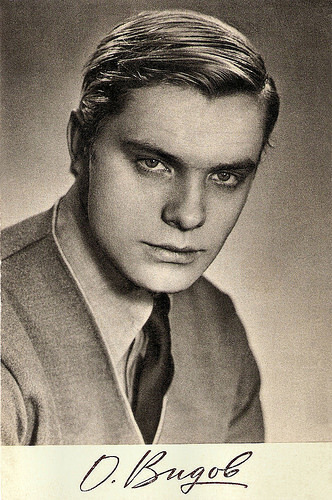
Russian postcard by Izdanije Byuro Propogandy Sovietskogo Kinoiskusstva, no. A 06242, 1968. This postcard was printed in an edition of 100.000 cards. Retail price: 10 Kop.
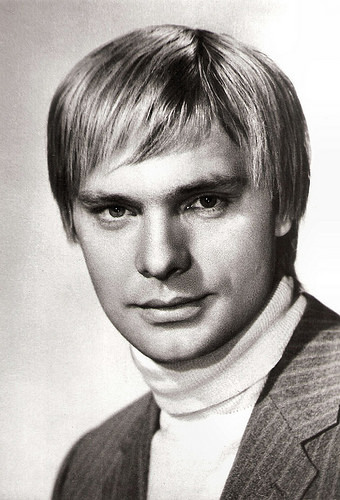
Russian postcard by Izdanije Byuro Propogandy Sovietskogo Kinoiskusstva, no. A 319, 1977. This postcard was printed in an edition of 40.000 cards. Retail price: 8 Kop.
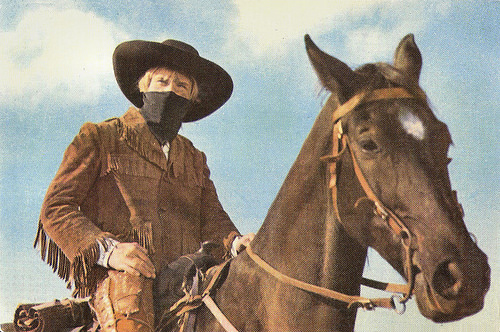
Russian postcard by Izdanije Byuro Propogandy Sovietskogo Kinoiskusstva, no. 6130, 1973. This postcard was printed in an edition of 400.000 cards. Retail price: 5 Kop. Photo: publicity still for Vsadnik bez golovy/The Headless Horseman (Vladimir Vaynshtok, 1972).
Communist Westerns
In Cuba, Oleg Vidov plated a poor Irish cowboy in the Western Всадник без головы/Vsadnik bez golovy/The Headless Horseman (Vladimir Vaynshtok, 1972), with Lyudmila Savelyeva . The film was based on a novel by the 19th-century Irish-American adventure writer ‘Captain’ Thomas Mayne Reid, whose works were much read in the Eastern Bloc. Cuban actors played the Hispanic characters and the black slaves; Soviet actors the Caucasians and Native Americans.
Vidov appeared in another communist Western, the DEFA production Tecumseh (Hans Kratzert, 1972) featuring Gojko Mitic . For the animation film Maugli/Adventures of Mowgli (Roman Davydov, 1973), he dubbed one the characters. The film, based on the book by Rudyard Kipling, was produced by Soviet animation studio Soyuzmultfilm. Other films in which he appeared were the Yugoslavian production Jad/Misery (Kiril Cenevski, 1975), and the crime film Крик тишины/Krik tishiny/Scream of Silence (Arya Dashiyev, 1983).
In 1985, Oleg Vidov emigrated to the U.S. (using his half-Jewish origin) and began acting in films and television there, without success. He married producer Joan Borsten and appeared in her production Red Heat (Walter Hill, 1988) starring Arnold Schwarzenegger as a taciturn law-enforcement officer from Russia. Vidov also helped Schwarzenegger to shape the role. The following year he had a part in the erotic drama Wild Orchid (Zalman King, 1990) starring Mickey Rourke.
In 1992, the Vidovs obtained the international distribution rights to the award-winning Soyuzmultfilm animation library. Their firm FBJ (Films By Jove) helped popularise Russian animation around the world. Together they produced numerous series based on animation they digitally restored from the Soyuzmultfilm library including Animated Classic Showcase, Mikhail Baryshnikov's Stories from My Childhood, Rudyard Kipling's The Jungle Book, Masters of Russian Animation, The Adventures of Cheburashka and Friends, and Animated Soviet Propaganda.
Incidentally Vidov appeared in Hollywood productions. The most interesting was the political thriller Thirteen Days (Roger Donaldson, 2000) about the Cuban Missile Crisis of 1962. Opposite Kevin Costner, Vidov played a supporting role as the Soviet Ambassador to the United Nations.
In 2007 Vidov and his wife sold the library to a Russian oligarch. Oleg Vidov became Chairman of the Board at Malibu Beach Recovery Center, a drug treatment facility in Malibu, California.
Oleg Vidov died in Westlake Village, California. He was 73.
Trailer Битка на Неретви/Bitka na Neretvi/Battle of Neretva (1969). Source: Иволий Иванов (YouTube).
Trailer Red Heat (1988). Source: Kilkenny1979 (YouTube).
Sources:

Russian postcard by Izdanije Byuro Propogandy Sovietskogo Kinoiskusstva, no. 4, 1973. This postcard was printed in an edition of 40,000 cards. Retail price: 8 Kop.

Russian postcard by Izdanije Byuro Propogandy Sovietskogo Kinoiskusstva, no. A 04747, 1968. This postcard was printed in an edition of 100.000 cards. Retail price: 8 Kop.
Bear Turned Man
Oleg Borisovich Vidov was born in Filimonki, a suburb of Moscow, USSR (now Russia) in 1943. His parents were Varvara Vidova, a teacher, and Boris Nikolaievich Garnevich, an economist. As a child he lived with his mother, who worked for the Soviet government in the field of education in Mongolia and East Germany. When his mother was sent to China on assignment, he went to live with his aunt Anuta in Kazakhstan. Eventually he moved with his mother and aunt to Moscow.
At 18, competing against hundreds of would-be actors, he was accepted to the acting department of the state film school VGIK. In 1961, he made his film debut with a bit part in the drama Друг мой, Колька!../Drug moy, Kolka!../My friend Kolka! (Aleksandr Mitta, Aleksei Saltykov, 1961). Eleanor Mannikka at AllMovie : “This was an unusual comedy for its day in the USSR. Put together by two graduate students in film, the story tweaks the establishment with some fairly sharp barbs. At the receiving end of the satire is the rigid, party-line, slogan-spouting school system and its load of propaganda.”
In 1964, the young actor played a bear-turned-man who falls in love with a princess in Обыкновенное чудо/Obyknovennoye chudo/An Ordinary Miracle (Erast Garin, 1964). This wonderful fairy love story was partly filmed in the Vorontsov Palace. Next, Vidov starred in Метель/Metel/The Blizzard (Vladimir Basov, 1964), based on a story by Alexander Pushkin.
He played a prince charming in the fairy tale Сказка о царе Салтане/Skazka o tsare Saltane/The Tale of Tsar Saltan (Aleksandr Ptushko, 1967) with Larisa Golubkina. In 1968, he went to Yugoslavia for the romance Ima ljubavi, nema ljubavi/There is love, no love (Nikola Rajic, 1968) with Olivera Katerina, and the war drama Uzrok smrti ne pominjati/Do Not Mention the Cause of Death (Jovan Zivanovic, 1968) starring Bekim Fehmiu.
Vidov also appeared in the Yugoslavian production Битка на Неретви/Bitka na Neretvi/Battle of Neretva (Veljko Bulajić, 1969) based on the true events of World War II. The Battle of the Neretva was due to a strategic plan for a combined Axis powers attack in 1943 against the Yugoslav Partisans. The plan was also known as the Fourth Enemy Offensive and occurred in the area of the Neretva river in Bosnia and Herzegovina.
Battle of Neretva was the most expensive film made in the SFR Yugoslavia. It was the first of the huge state-sponsored World War II film productions and had a staggering budget (somewhere between $4.5 million and $12 million) approved personally by Yugoslav president Josip Tito. In the cast were global stars like Sergei Bondarchuk (who had just won an Oscar for War and Peace), Yul Brynner , Franco Nero , Orson Welles , Hardy Krüger and Sylva Koscina . Battle of Neretva was nominated for the Academy Award for Best Foreign Language Film, but did not win.
Vidov was then cast for another historical epic Ватерлоо/Waterloo (1970), directed by Sergei Bondarchuk and produced by Dino De Laurentiis. The cast included Rod Steiger (as Napoleon Bonaparte), Christopher Plummer (as the Duke of Wellington), Orson Welles (Louis XVIII of France), Jack Hawkins , and Virginia McKenna . Waterloo depicts the story of the preliminary events and the Battle of Waterloo, and is famous for its lavish battle scenes.

Russian postcard by Izdanije Byuro Propogandy Sovietskogo Kinoiskusstva, no. A 06242, 1968. This postcard was printed in an edition of 100.000 cards. Retail price: 10 Kop.

Russian postcard by Izdanije Byuro Propogandy Sovietskogo Kinoiskusstva, no. A 319, 1977. This postcard was printed in an edition of 40.000 cards. Retail price: 8 Kop.

Russian postcard by Izdanije Byuro Propogandy Sovietskogo Kinoiskusstva, no. 6130, 1973. This postcard was printed in an edition of 400.000 cards. Retail price: 5 Kop. Photo: publicity still for Vsadnik bez golovy/The Headless Horseman (Vladimir Vaynshtok, 1972).
Communist Westerns
In Cuba, Oleg Vidov plated a poor Irish cowboy in the Western Всадник без головы/Vsadnik bez golovy/The Headless Horseman (Vladimir Vaynshtok, 1972), with Lyudmila Savelyeva . The film was based on a novel by the 19th-century Irish-American adventure writer ‘Captain’ Thomas Mayne Reid, whose works were much read in the Eastern Bloc. Cuban actors played the Hispanic characters and the black slaves; Soviet actors the Caucasians and Native Americans.
Vidov appeared in another communist Western, the DEFA production Tecumseh (Hans Kratzert, 1972) featuring Gojko Mitic . For the animation film Maugli/Adventures of Mowgli (Roman Davydov, 1973), he dubbed one the characters. The film, based on the book by Rudyard Kipling, was produced by Soviet animation studio Soyuzmultfilm. Other films in which he appeared were the Yugoslavian production Jad/Misery (Kiril Cenevski, 1975), and the crime film Крик тишины/Krik tishiny/Scream of Silence (Arya Dashiyev, 1983).
In 1985, Oleg Vidov emigrated to the U.S. (using his half-Jewish origin) and began acting in films and television there, without success. He married producer Joan Borsten and appeared in her production Red Heat (Walter Hill, 1988) starring Arnold Schwarzenegger as a taciturn law-enforcement officer from Russia. Vidov also helped Schwarzenegger to shape the role. The following year he had a part in the erotic drama Wild Orchid (Zalman King, 1990) starring Mickey Rourke.
In 1992, the Vidovs obtained the international distribution rights to the award-winning Soyuzmultfilm animation library. Their firm FBJ (Films By Jove) helped popularise Russian animation around the world. Together they produced numerous series based on animation they digitally restored from the Soyuzmultfilm library including Animated Classic Showcase, Mikhail Baryshnikov's Stories from My Childhood, Rudyard Kipling's The Jungle Book, Masters of Russian Animation, The Adventures of Cheburashka and Friends, and Animated Soviet Propaganda.
Incidentally Vidov appeared in Hollywood productions. The most interesting was the political thriller Thirteen Days (Roger Donaldson, 2000) about the Cuban Missile Crisis of 1962. Opposite Kevin Costner, Vidov played a supporting role as the Soviet Ambassador to the United Nations.
In 2007 Vidov and his wife sold the library to a Russian oligarch. Oleg Vidov became Chairman of the Board at Malibu Beach Recovery Center, a drug treatment facility in Malibu, California.
Oleg Vidov died in Westlake Village, California. He was 73.
Trailer Битка на Неретви/Bitka na Neretvi/Battle of Neretva (1969). Source: Иволий Иванов (YouTube).
Trailer Red Heat (1988). Source: Kilkenny1979 (YouTube).
Sources:
Published on May 16, 2017 22:00
May 15, 2017
Mathilda May
Beautiful and talented Mathilda May (1965) is a French film actress. Her film work is primarily in French and made by such acclaimed directors as Claude Chabrol, Werner Herzog, and Jacques Demy. She also appeared in a few Hollywood blockbusters, but with little success.
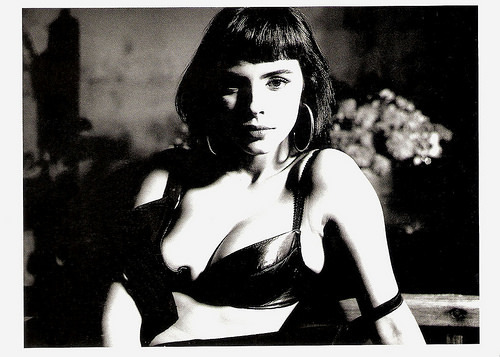
French postcard by Musée de l 'Elysée, Lausanne / News Productions, Baulmes. Photo: Bettina Rheims / Sygma. Caption: Mathilda May - La Beauce, 1987.
A deep-tanned, brown-eyed beauty
Mathilda May was born Karima Mathilda Haim in Paris in 1965. Her father is playwright Victor Haïm, who is from a Greek- and Turkish-Jewish family. Her mother is the Swedish ballet teacher and choreographer Margareta Hanson. She was a prima ballerina for the Sweden Malmo ballet company.
At age 16 May won the Premier Prix du Conservatoire de Danse de Paris (First Prize of the Paris Dance Conservatory). After a part in a German TV series, she made her film debut opposite Jason Connery in the fantasy Nemo/Dream One (Arnaud Sélignac, 1984). Jason Buchanan at AllMovie about her: “A deep-tanned, brown-eyed beauty whose background in ballet lends her a certain onscreen elegance unrivalled by many of her contemporaries.”
Internationally she is best known for her role as a seductive vampire in the British Science Fiction horror film Lifeforce (Tobe Hooper, 1985), with Steve Railsback and Peter Firth. Wikipedia notes that May is naked for most of her performance in this film. Lifeforce was the first film of Tobe Hooper's three-picture deal with Cannon Films, following his enormous success with Poltergeist (1982), which was a collaboration with producer Steven Spielberg. The other two films are the remake of Invaders from Mars (1986) and The Texas Chainsaw Massacre 2 (1986).
May followed this with parts in French films such as the comedy Les Rois du gag/The Gag Kings (Claude Zidi, 1985) with Michel Serrault , and La vie dissolue de Gérard Floque/The Debauched Life of Gérard Floque (Georges Lautner, 1987).
She won a César award for Most Promising Actress for her role in the French-Italian thriller Le cri du hibou/The Cry of the Owl (Claude Chabrol, 1987) based on a novel by Patricia Highsmith. She starred opposite Yves Montand in the musical Trois places pour le 26/Three Seats for the 26th (1988), scripted and directed by Jacques Demy to music by Michel Legrand. In 1989, she was the recipient of the Prix Romy Schneider.
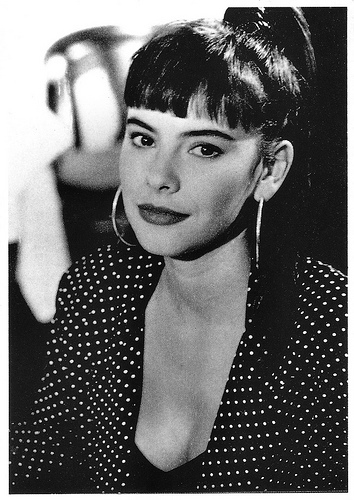
French postcard by Especially for you, Réf. 7.
Joy of Love
During the 1990s, Mathilda May appeared in such non-French films as Naked Tango (Leonard Schrader, 1991) with Vincent D'Onofrio, Becoming Colette (Danny Huston, 1991) and the Spanish-French production La Teta y la luna/The Tit and the Moon (Bigas Luna, 1994) with Gérard Darmon.
She also appeared in the space adventure game Privateer 2: The Darkening (Steve Hilliker, Erin Roberts, 1996) and played the Basque terrorist Isabella in the action film The Jackal (Michael Caton-Jones, 1997) with Bruce Willis and Richard Gere.
Her most interesting film of this period is Cerro Torre: Schrei aus Stein/Scream of Stone (Werner Herzog, 1991) about a climbing expedition on Cerro Torre, one of the mountains of the Southern Patagonian Ice Field in South America. The film was shot on location at Cerro Torre, with several scenes filmed close to the summit.
In 1992, May recorded an album called Joy of Love. In the following deacades May mostly worked for TV. Her incidental French films include Là-bas... mon pays/Return to Algiers (Alexandre Arcady, 2000), the drama and thriller La Fille coupée en deux/A Girl Cut in Two (Claude Chabrol, 2007) starring Ludivine Sagnier, and the omnibus comedy Les Infidèles/The Players (2012) directed by and starring Jean Dujardin and Gilles Lellouche.
Mathilda May has been married three times. Her first husband was Paul Powell, while her second husband was French actor and singer Gérard Darmon, with whom she has two children, daughter Sarah (1994) and son Jules (1997). Her third husband was Philippe Kelly.
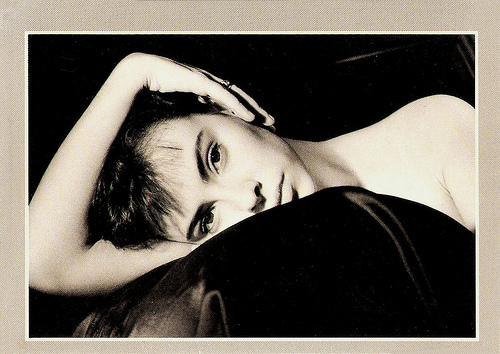
French postcard in the Le jour se lève series by Editions Humour à la carte, Paris, no. ST-177. Photo: Jean-Pierre Larcher.
Sources: Jason Buchanan (AllMovie), Wikipedia, and .

French postcard by Musée de l 'Elysée, Lausanne / News Productions, Baulmes. Photo: Bettina Rheims / Sygma. Caption: Mathilda May - La Beauce, 1987.
A deep-tanned, brown-eyed beauty
Mathilda May was born Karima Mathilda Haim in Paris in 1965. Her father is playwright Victor Haïm, who is from a Greek- and Turkish-Jewish family. Her mother is the Swedish ballet teacher and choreographer Margareta Hanson. She was a prima ballerina for the Sweden Malmo ballet company.
At age 16 May won the Premier Prix du Conservatoire de Danse de Paris (First Prize of the Paris Dance Conservatory). After a part in a German TV series, she made her film debut opposite Jason Connery in the fantasy Nemo/Dream One (Arnaud Sélignac, 1984). Jason Buchanan at AllMovie about her: “A deep-tanned, brown-eyed beauty whose background in ballet lends her a certain onscreen elegance unrivalled by many of her contemporaries.”
Internationally she is best known for her role as a seductive vampire in the British Science Fiction horror film Lifeforce (Tobe Hooper, 1985), with Steve Railsback and Peter Firth. Wikipedia notes that May is naked for most of her performance in this film. Lifeforce was the first film of Tobe Hooper's three-picture deal with Cannon Films, following his enormous success with Poltergeist (1982), which was a collaboration with producer Steven Spielberg. The other two films are the remake of Invaders from Mars (1986) and The Texas Chainsaw Massacre 2 (1986).
May followed this with parts in French films such as the comedy Les Rois du gag/The Gag Kings (Claude Zidi, 1985) with Michel Serrault , and La vie dissolue de Gérard Floque/The Debauched Life of Gérard Floque (Georges Lautner, 1987).
She won a César award for Most Promising Actress for her role in the French-Italian thriller Le cri du hibou/The Cry of the Owl (Claude Chabrol, 1987) based on a novel by Patricia Highsmith. She starred opposite Yves Montand in the musical Trois places pour le 26/Three Seats for the 26th (1988), scripted and directed by Jacques Demy to music by Michel Legrand. In 1989, she was the recipient of the Prix Romy Schneider.

French postcard by Especially for you, Réf. 7.
Joy of Love
During the 1990s, Mathilda May appeared in such non-French films as Naked Tango (Leonard Schrader, 1991) with Vincent D'Onofrio, Becoming Colette (Danny Huston, 1991) and the Spanish-French production La Teta y la luna/The Tit and the Moon (Bigas Luna, 1994) with Gérard Darmon.
She also appeared in the space adventure game Privateer 2: The Darkening (Steve Hilliker, Erin Roberts, 1996) and played the Basque terrorist Isabella in the action film The Jackal (Michael Caton-Jones, 1997) with Bruce Willis and Richard Gere.
Her most interesting film of this period is Cerro Torre: Schrei aus Stein/Scream of Stone (Werner Herzog, 1991) about a climbing expedition on Cerro Torre, one of the mountains of the Southern Patagonian Ice Field in South America. The film was shot on location at Cerro Torre, with several scenes filmed close to the summit.
In 1992, May recorded an album called Joy of Love. In the following deacades May mostly worked for TV. Her incidental French films include Là-bas... mon pays/Return to Algiers (Alexandre Arcady, 2000), the drama and thriller La Fille coupée en deux/A Girl Cut in Two (Claude Chabrol, 2007) starring Ludivine Sagnier, and the omnibus comedy Les Infidèles/The Players (2012) directed by and starring Jean Dujardin and Gilles Lellouche.
Mathilda May has been married three times. Her first husband was Paul Powell, while her second husband was French actor and singer Gérard Darmon, with whom she has two children, daughter Sarah (1994) and son Jules (1997). Her third husband was Philippe Kelly.

French postcard in the Le jour se lève series by Editions Humour à la carte, Paris, no. ST-177. Photo: Jean-Pierre Larcher.
Sources: Jason Buchanan (AllMovie), Wikipedia, and .
Published on May 15, 2017 22:00
May 14, 2017
Linda Pini
Linda Pini (1896-1971) was an actress of the Italian cinema, in particular the silent cinema. Her career span from 1916 to 1943.
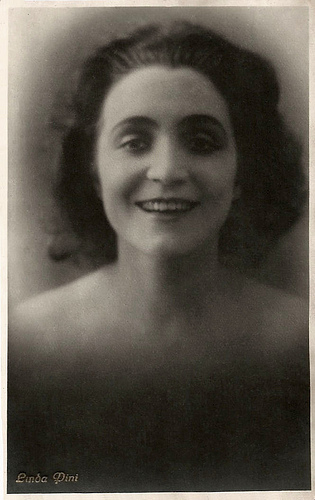
Italian postcard by G.B. Falci, Milano (Milan), no. 75.
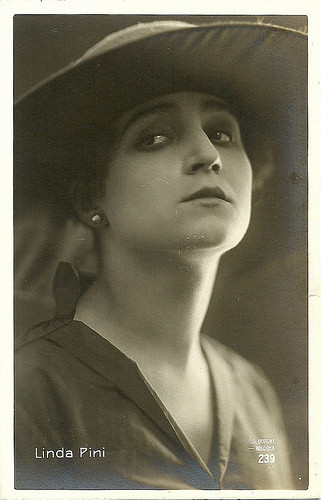
Italian postcard by Ed. Borghi, Bologna, no. 239.
Hidden Beauty
Linda Pini was born as Gerlinda Filippini in Milan in 1896.
She probably made her film debut as Santuzza in the adaptation of Giovanni Verga’s drama Cavalleria rusticana (1916), directed by Ubaldo Maria Del Colle, who also played Turiddu. At the time the film was accompanied by the music of Pietro Mascagni’s homonymous opera.
Del Colle directed her again in Zingari/Gypsies (Ubaldo Maria Del Colle, 1916), another example of a famous story (by Alexander Pushkin) turned into an opera (by Ruggero Leoncavallo), turned into a film. Again Pini had the leading role. The press praised not only Pini’s performance, but also the spectacle side of the film and the costumes by Caramba, who was then already a well-known set and costume designer at the theatre.
After that Pini had to step down, playing minor parts in two films with diva Helena Makowska , both Gabriele D’Annunzio adaptations: La fiaccola sotto il moggio/The Torch Under thye Moggio (Eleuterio Ridolfi, 1916) and La Gioconda/The Joyous one (Eleuterio Ridolfi, 1916). The films were popular.
Pini then went to play for the Silentium Film company in Milan, where she had leading roles, first in L’illusione/The illusion (Guglielmo Zorzi, 1917), which the press disliked, while another film by Zorzi, La felicità/The happiness (Guglielmo Zorzi, 1918), was lauded for Pini’s performance.
The press complained when Pini’s beauty was constantly hidden in another Silentium production, La storia di una capinera/The History of a Sparrow (Giuseppe Sterni, 1917). The film about a nun who goes berserk, was based on a novel by Giovanni Verga. The next Silentium production La nemica/The Enemy (Ivo Illuminati, 1917), based on the play by Dario Niccodemi, got better reviews. Zorzi was supposed to direct this film too, but was called under the arms, so Illuminati replaced him.
Illuminati also directed Pini in Giflée (Ivo Illuminati, 1918), in which Pini was a spoiled American who changes her life, travels to Europe and does all kinds of odd jobs. Pini then moved to Turin to play in Mario Bonnard’s Il rifugio dell’alba, with Bonnard also as her co-star.
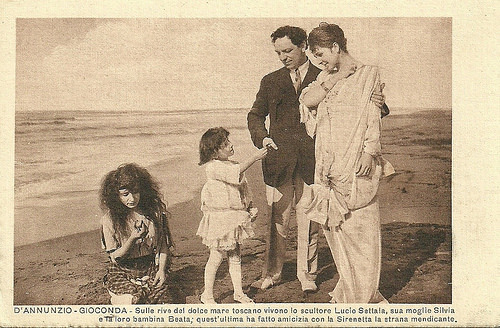
Italian postcard by IPA CT, no. 3872, V. Uff. Rev. St., Terni. Photo: Ambrosio. Caption: 'On the banks of the sweet Tuscan coast the sculptor Lucio Settala, his wife Silvia and their daughter Beata live. The latter has befriended the Little Siren, a strange beggar girl.' Postcard for the lost Ambrosio production La Gioconda (Eleuterio Rodolfi, 1916, released 1917), based on Gabriele D'Annunzio's play. While Umberto Mozzato plays Settala and Mercedes Brignone his wife, 'Sirenetta' might be Linda Pini.
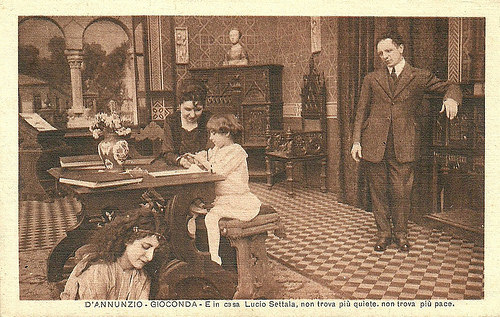
Italian postcard. IPA CT, V. Uff. Rev. St. Terni, no. 3881. Photo: Film della Soc. Ambrosio, Torino. Caption: 'And at home Lucio Settala didn't find rest nor peace.' Standing right, Settala (Umberto Mozzato), sitting at the table his wife Silvia ( Mercedes Brignone ), and sitting on the (fore-)ground la Sirenetta (Linda Pini).
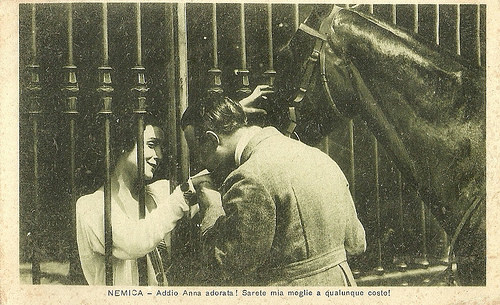
Italian postcard by IPA CT Duplex, no. 7209. Photo: Silentium-Film. Linda Pini in the Italian silent film La nemica/The Enemy (Ivo Illuminati, 1917), adapted from the play by Dario Nicodemi. Caption: 'Farewell, beloved Anna! You will become my wife at any cost!'
Diva Status
At the end of the First World War, Linda Pini moved to Rome where she starred in Zorzi’s film La cicala/The Cricket (Guglielmo Zorzi, 1919), in which she plays a vamp, the cricket of the film’s title.
Subsequent films were L’estranea/The extraneous one (Achille Consalvi, 1919), the Henry Bernstein adaptation Elevazione/Elevation (Telemaco Ruggeri, 1920), and Temi/Themes (Gaston Ravel, 1920) which was praised for Pini’s performance as a female lawyer who defends a young man accused of murder.
By this time Pini had reached the status of diva, though the Italian press didn’t like her too much. Next followed such films as I dannati/The damned ( Jacques Creusy, 1921), Favilla (Ivo Illuminati, 1921), and I disonesti/The cheats (Giuseppe Sterni, 1922).
In 1923 followed Il paese della paura/The country of fear (Alfredo De Antoni, 1923), La leggenda delle Dolomiti/The legend of the Dolomites (Guglielmo Zorzi, 1923) opposite Arnold Kent , Povere bimbi/Poor Babies (Giovanni Pastrone, 1923), and Fronda d’ulivo/The Olive Branch (Alfredo De Antoni, 1923).
Then came parts in Il cammino delle stelle/The walk of the stars (Guglielmo Zorzi, 1924), La freccia nel cuore/The arrow in the heart (Amleto Palermi, 1925), and Voglio tradire il mio marito/I Want to Betray My Husband (Mario Camerini, 1925).
After an interval of several years followed the late silent film La leggenda di Wally/La Wally (Gian Orlando Vassallo, 1930), based on the Henny Porten -film Die Geier-Wally (Ewald André Dupont, 1921). It was her last role as a silent star.
In the sound era Lina Pini played only two parts: in Fuochi d’artificio/Fireworks (Gennaro Righelli, 1938), were she had a major part opposite Amedeo Nazzari but under the pseudonym Gery Land, and in La zia di Carlo/Charlie's Aunt (Alfredo Guarini, 1943), a minor part as the real aunt.
It is told that Linda Pini died poor and forgotten, in Rome in 1971. She was 77.
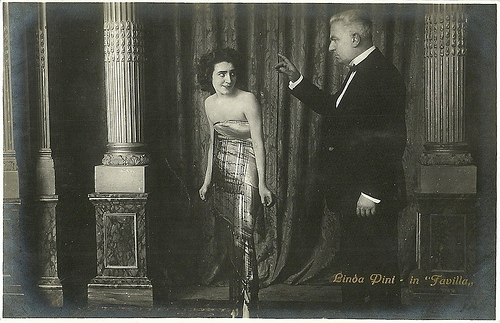
Italian postcard by Ed. G.B. Falci, Milano. Photo: Medusa-Film. Linda Pini in Favilla/Love's Labour Won (Ivo Illuminati, 1921).
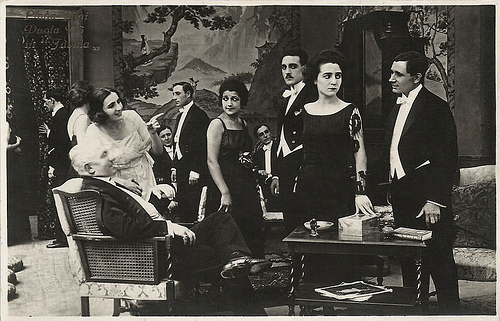
Italian postcard by G.B. Falci, Milano (Milan), no. 121. Photo: La Photominio. Publicity still for Favilla (Ivo Illuminati, 1921). At the time, this film of the Roman Medusa-Film company was not so much praised for its story as rather for its performances and the cinematography. Linda Pini plays Favilla, who is secretly in love with Cesare (Carlo Gualendri), a young engineering student and her cousin. One day Lady d'Etemps (Paola Pò) and her cousin Guglielmo visit the house of Favilla's uncle. The lady tries to seduce Cesare, because she loves his money and future inheritance. She also tries to match her cousin with Favilla. When Favilla unmasks the lady's financial interests, the other unmasks Favilla's love for Cesare. While the others leave, Cesare and Favilla exchange their first kiss...
Sources: Vittorio Martinelli (Il cinema muto italiano), Wikipedia (Italian) and .

Italian postcard by G.B. Falci, Milano (Milan), no. 75.

Italian postcard by Ed. Borghi, Bologna, no. 239.
Hidden Beauty
Linda Pini was born as Gerlinda Filippini in Milan in 1896.
She probably made her film debut as Santuzza in the adaptation of Giovanni Verga’s drama Cavalleria rusticana (1916), directed by Ubaldo Maria Del Colle, who also played Turiddu. At the time the film was accompanied by the music of Pietro Mascagni’s homonymous opera.
Del Colle directed her again in Zingari/Gypsies (Ubaldo Maria Del Colle, 1916), another example of a famous story (by Alexander Pushkin) turned into an opera (by Ruggero Leoncavallo), turned into a film. Again Pini had the leading role. The press praised not only Pini’s performance, but also the spectacle side of the film and the costumes by Caramba, who was then already a well-known set and costume designer at the theatre.
After that Pini had to step down, playing minor parts in two films with diva Helena Makowska , both Gabriele D’Annunzio adaptations: La fiaccola sotto il moggio/The Torch Under thye Moggio (Eleuterio Ridolfi, 1916) and La Gioconda/The Joyous one (Eleuterio Ridolfi, 1916). The films were popular.
Pini then went to play for the Silentium Film company in Milan, where she had leading roles, first in L’illusione/The illusion (Guglielmo Zorzi, 1917), which the press disliked, while another film by Zorzi, La felicità/The happiness (Guglielmo Zorzi, 1918), was lauded for Pini’s performance.
The press complained when Pini’s beauty was constantly hidden in another Silentium production, La storia di una capinera/The History of a Sparrow (Giuseppe Sterni, 1917). The film about a nun who goes berserk, was based on a novel by Giovanni Verga. The next Silentium production La nemica/The Enemy (Ivo Illuminati, 1917), based on the play by Dario Niccodemi, got better reviews. Zorzi was supposed to direct this film too, but was called under the arms, so Illuminati replaced him.
Illuminati also directed Pini in Giflée (Ivo Illuminati, 1918), in which Pini was a spoiled American who changes her life, travels to Europe and does all kinds of odd jobs. Pini then moved to Turin to play in Mario Bonnard’s Il rifugio dell’alba, with Bonnard also as her co-star.

Italian postcard by IPA CT, no. 3872, V. Uff. Rev. St., Terni. Photo: Ambrosio. Caption: 'On the banks of the sweet Tuscan coast the sculptor Lucio Settala, his wife Silvia and their daughter Beata live. The latter has befriended the Little Siren, a strange beggar girl.' Postcard for the lost Ambrosio production La Gioconda (Eleuterio Rodolfi, 1916, released 1917), based on Gabriele D'Annunzio's play. While Umberto Mozzato plays Settala and Mercedes Brignone his wife, 'Sirenetta' might be Linda Pini.

Italian postcard. IPA CT, V. Uff. Rev. St. Terni, no. 3881. Photo: Film della Soc. Ambrosio, Torino. Caption: 'And at home Lucio Settala didn't find rest nor peace.' Standing right, Settala (Umberto Mozzato), sitting at the table his wife Silvia ( Mercedes Brignone ), and sitting on the (fore-)ground la Sirenetta (Linda Pini).

Italian postcard by IPA CT Duplex, no. 7209. Photo: Silentium-Film. Linda Pini in the Italian silent film La nemica/The Enemy (Ivo Illuminati, 1917), adapted from the play by Dario Nicodemi. Caption: 'Farewell, beloved Anna! You will become my wife at any cost!'
Diva Status
At the end of the First World War, Linda Pini moved to Rome where she starred in Zorzi’s film La cicala/The Cricket (Guglielmo Zorzi, 1919), in which she plays a vamp, the cricket of the film’s title.
Subsequent films were L’estranea/The extraneous one (Achille Consalvi, 1919), the Henry Bernstein adaptation Elevazione/Elevation (Telemaco Ruggeri, 1920), and Temi/Themes (Gaston Ravel, 1920) which was praised for Pini’s performance as a female lawyer who defends a young man accused of murder.
By this time Pini had reached the status of diva, though the Italian press didn’t like her too much. Next followed such films as I dannati/The damned ( Jacques Creusy, 1921), Favilla (Ivo Illuminati, 1921), and I disonesti/The cheats (Giuseppe Sterni, 1922).
In 1923 followed Il paese della paura/The country of fear (Alfredo De Antoni, 1923), La leggenda delle Dolomiti/The legend of the Dolomites (Guglielmo Zorzi, 1923) opposite Arnold Kent , Povere bimbi/Poor Babies (Giovanni Pastrone, 1923), and Fronda d’ulivo/The Olive Branch (Alfredo De Antoni, 1923).
Then came parts in Il cammino delle stelle/The walk of the stars (Guglielmo Zorzi, 1924), La freccia nel cuore/The arrow in the heart (Amleto Palermi, 1925), and Voglio tradire il mio marito/I Want to Betray My Husband (Mario Camerini, 1925).
After an interval of several years followed the late silent film La leggenda di Wally/La Wally (Gian Orlando Vassallo, 1930), based on the Henny Porten -film Die Geier-Wally (Ewald André Dupont, 1921). It was her last role as a silent star.
In the sound era Lina Pini played only two parts: in Fuochi d’artificio/Fireworks (Gennaro Righelli, 1938), were she had a major part opposite Amedeo Nazzari but under the pseudonym Gery Land, and in La zia di Carlo/Charlie's Aunt (Alfredo Guarini, 1943), a minor part as the real aunt.
It is told that Linda Pini died poor and forgotten, in Rome in 1971. She was 77.

Italian postcard by Ed. G.B. Falci, Milano. Photo: Medusa-Film. Linda Pini in Favilla/Love's Labour Won (Ivo Illuminati, 1921).

Italian postcard by G.B. Falci, Milano (Milan), no. 121. Photo: La Photominio. Publicity still for Favilla (Ivo Illuminati, 1921). At the time, this film of the Roman Medusa-Film company was not so much praised for its story as rather for its performances and the cinematography. Linda Pini plays Favilla, who is secretly in love with Cesare (Carlo Gualendri), a young engineering student and her cousin. One day Lady d'Etemps (Paola Pò) and her cousin Guglielmo visit the house of Favilla's uncle. The lady tries to seduce Cesare, because she loves his money and future inheritance. She also tries to match her cousin with Favilla. When Favilla unmasks the lady's financial interests, the other unmasks Favilla's love for Cesare. While the others leave, Cesare and Favilla exchange their first kiss...
Sources: Vittorio Martinelli (Il cinema muto italiano), Wikipedia (Italian) and .
Published on May 14, 2017 22:00
May 13, 2017
Exported to the USA: Arnold Schwarzenegger
Austrian-born muscleman, Hollywood star and politician Arnold Schwarzenegger (1947) started his career as a bodybuilder, who won several European contests and international titles. ‘The Austrian Oak’ moved to the US and was a millionaire at 21. He achieved stardom in the documentary Pumping Iron (1977) and established himself as an action star with Conan the Barbarian (1982). As the murderous android title character in The Terminator (1984) and its sequels, Schwarzenegger became a bona fide box-office draw and the cigar-chomping strongman went on to star in interesting box office hits as Predator (1987), Total Recall (1990) and True Lies (1994). His most notable role of the new millennium was political - as governor of California.
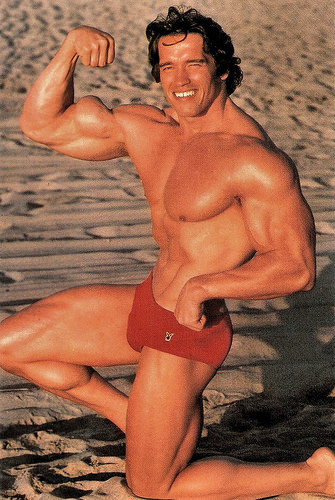
Canadian Fan Club Post Card, no. PC 13.
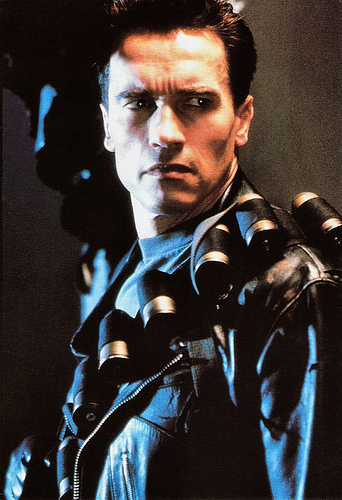
American postcard by Classico San Francisco, no. 105-139. Photo: Carolco Pictures Inc. Publicity still for Terminator 2 Judgment Day (James Cameron, 1991).
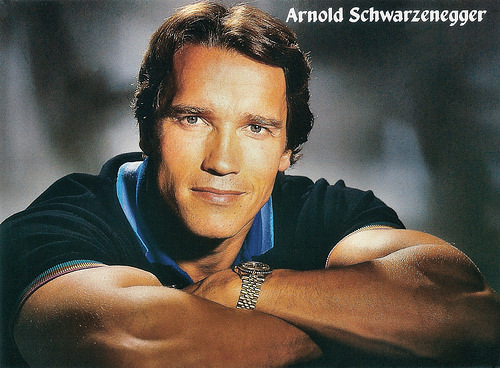
British postcard by Minerva / Holmes McDougall Ltd., Edinburgh, no. PC 311.
The Austrian Oak
Arnold Alois Schwarzenegger was born in 1947 in the village Thal near the small Austrian town of Graz. His parents were Gustav and Aurelia Schwarzenegger.
His father, was an alcoholic police chief and one-time member of the Nazi Party, who clearly favoured Arnold's brother over his gangly, seemingly less athletic younger son. Gustav is reported to have beaten and intimidated Arnold and pitted his two boys against one another. Schwarzenegger would later refuse to attend the funeral of his father, who died in 1972, or his brother, who was killed in a car crash in 1971.
Gustav wanted Arnold to become a soccer player, but the 15-year-old opted for weight training. He frequented the local cinemas to see bodybuilding idols such as Reg Park and Steve Reeves on the big screen. In 1961, Schwarzenegger met former Mr. Austria Kurt Marnul, who invited him to train at the gym in Graz.
During his army service in 1965, Arnold won the Junior Mr. Europe contest. Arnold went on to win several European contests. This was his ticket to the U.S., where he billed himself for body-building exhibitions as ‘The Austrian Oak’. At age 20, he won the first of five Mr. Universe titles, and three years later, he captured his first Mr. Olympia title. He would win the title a total of seven times.
Hal Erickson at AllMovie : “Though his thick Austrian accent and slow speech patterns led some to believe that the Austrian Oak was shy a few leaves, Schwarzenegger was, in fact, a highly motivated and intelligent young man. After graduating from the University of Wisconsin with a degree in business and economics, he invested his contest earnings in real estate and a mail-order bodybuilding equipment company.”
At 21, Schwarzenegger was a millionaire via shrewd investments and decided to try acting. Producers were impressed by his physique but not by his last name, so he made his film debut with a dubbed voice and as Arnold Strong in Hercules in New York (Arthur A. Seidelman, 1970), a low-budget parody of the sword and sandal epics of Arnold’s youth.
He reverted to his own name for Stay Hungry (Bob Rafelson, 1976), with Jeff Bridges. For his part, he was awarded a Golden Globe for New Male Star of the Year. Then he achieved stardom as ‘himself’ in Pumping Iron (George Butler, Robert Fiore, 1977) about a group of men training for the Mr. Olympia contest. Arnold had already won the title six times before, and was training for his seventh victory before retiring to fully pursue his acting career.
In The Villain (Hal Needham, 1979), a cartoon-like Western parody, he played ‘Handsome Stranger,’ exhibiting a gift for understated. In 1980, he starred opposite Loni Anderson in the TV biopic The Jayne Mansfield Story (Dick Lowry, 1980) as Mansfield's husband, Mickey Hargitay.
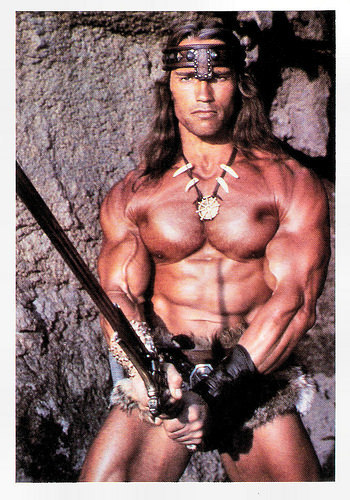
French postcard by Humour à la Carte, Paris, no. ST-59. Photo: publicity still for Conan the Barbarian (John Milius, 1982).

Italian postcard by World Collection, no. P.c. 306. Photo: publicity still for Commando (Mark L. Lester, 1985).
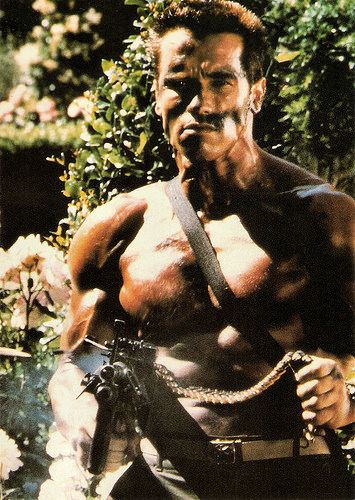
Italian postcard by Vitorius Roma, no. 404. Photo: publicity still for Commando (Mark L. Lester, 1985).
A bona fide box-office draw
Arnold Schwarzenegger established himself as an action star with his role as the barbarian warrior Conan in the formidable Conan the Barbarian (John Milius, 1982) and its inferior though enjoyable sequel, Conan the Destroyer (Richard Fleischer, 1984).
As the murderous android title character in The Terminator (James Cameron, 1984), Schwarzenegger became a bona fide box-office draw. Made on a relatively modest budget, the high voltage action / science fiction thriller was incredibly successful worldwide, and began one of the most profitable film franchises in history. Schwarzenegger's catchphrase "I'll be baaaack" became part of popular culture around the world.
Then followed two of his best action films: Predator (John McTiernan, 1987) - an entertaining marriage of action and science fiction about a team of commandos hunted by an extra-terrestrial warrior in a South-American jungle, and Paul Verhoeven's wild and sublime Sci-Fi action film Total Recall (Paul Verhoeven, 1990).
Total Recall, loosely based on the Philip K. Dick story We Can Remember It for You Wholesale, tells the story of a construction worker who goes for virtual vacation memories of the planet Mars, but an unexpected and harrowing events force him to go to the planet for real - or does he?
Stuart Wood at IMDb : “Total Recall is without doubt Arnold Schwarzenegger's best movie since The Terminator. Arnold fits perfectly in the role of Doug Quaid (definitely his best acting in a movie to date) the confused construction worker and Ronny Cox provides his usual evil plotting arch bad-guy. The impressive visual effects are worth the movie's $100 million price tag, and Paul Verhoeven proved that, as with Robocop and Starship Troopers, sci-fi is where he does his best work.“
As Danny De Vito's unlikely pacifistic sibling in Twins (Ivan Reitman, 1988), Schwarzenegger received the praise of critics. In the police comedy Kindergarten Cop (Ivan Reitman, 1991), Schwarzenegger played a hard-bitten police detective who found his true life's calling as a schoolteacher.
Terminator 2: Judgment Day (James Cameron, 1991), wherein ‘Arnie’ exercised his star prerogative and insisted that the Terminator become a good guy, was the most expensive film ever made up to its time and became one of the biggest moneymakers. The actor's subsequent action films were equally as costly.
Hal Erickson: “sometimes the expenditures paid off, while other times the result was immensely disappointing - for the box-office disappointment Last Action Hero (1992), Schwarzenegger refreshingly took full responsibility, rather than blaming the failure on his production crew or studio.”
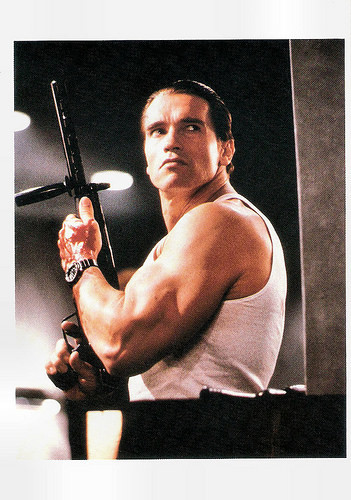
British postcard, no. 105. Publicity still for Raw Deal (John Irvin, 1986).
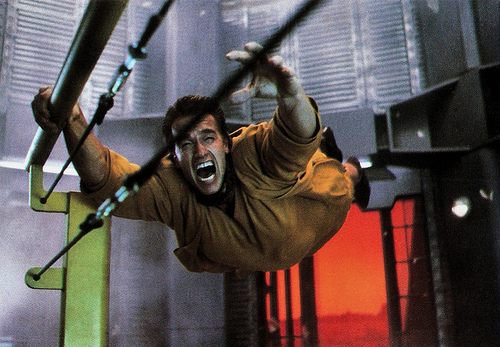
French postcard by Sonis, no. C. 129. Photo: Carolco International NV. Publicity still for Total Recall (Paul Verhoeven, 1990).
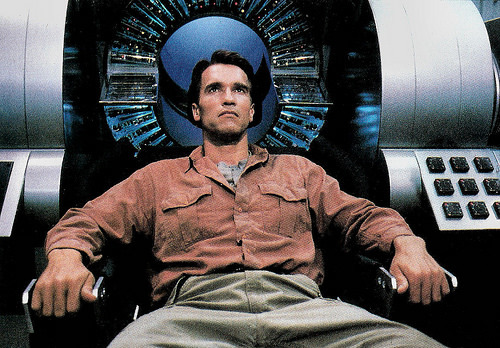
French postcard by Sonis, no. C. 130. Photo: Carolco International NV. Publicity still for Total Recall (Paul Verhoeven, 1990).
Mr. Freeze
Arnold Schwarzenegger is a rock-ribbed Republican despite his former marriage to JFK's niece, Maria Shriver, with whom he has four children. He was appointed by George Bush in 1990 as chairman of the President's Council of Physical Fitness and Sports, a job he took as seriously and with as much dedication as any of his films.
A much-publicised investment in the showbiz eatery Planet Hollywood increased the coffers in Schwarzenegger's already bulging bank account. Schwarzenegger then added directing to his many accomplishments, piloting a few episodes of the TV series Tales From the Crypt as well as the TV-movie Christmas in Connecticut (1992) with Dyan Cannon, a remake of the classic Christmas in Connecticut (Peter Godfrey, 1945) with Barbara Stanwyck.
Schwarzenegger bounced back from the disastrous Last Action Hero (John McTiernan, 1990) with True Lies (James Cameron, 1994), which was one of the major hits of that summer.
Following the success of True Lies, Schwarzenegger went back to doing comedy with Junior (Ivan Reitman, 1994), co-starring with Emma Thompson. The film met with critically mixed results, although it fared decently at the box office.
Schwarzenegger continued to alternate action with comedy with Eraser (Chuck Russell, 1996) and Jingle All the Way (Brian Levant, 1996). The latter proved to be both a critical bomb and a box-office disappointment. Schwarzenegger returned to action films with Batman & Robin (Joel Schumacher, 1997), in which he played the villain Mr. Freeze. Unfortunately the film proved to be a huge critical disappointment.
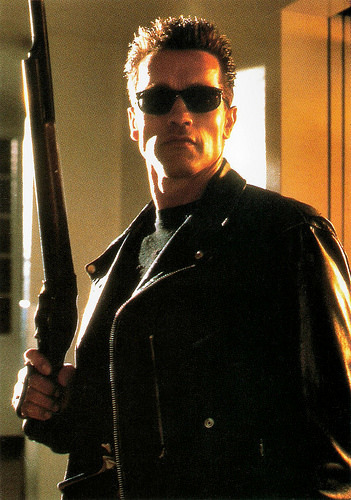
Dutch postcard by Film Freak Productions, no. FA 283, 1992. Photo: Carolco International N.V. Publicity still for Terminator 2: Judgment Day (James Cameron, 1991).
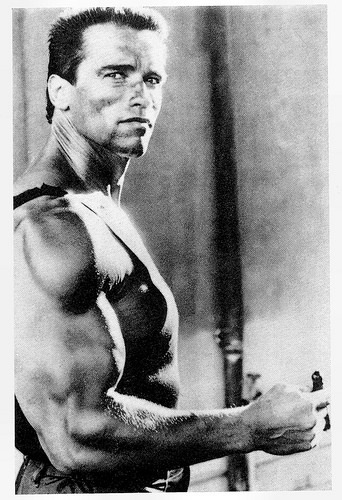
French postcard, no. S 118.
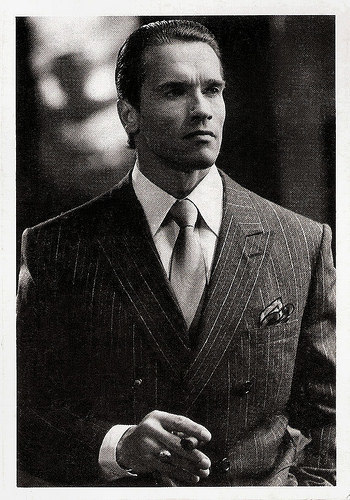
French postcard by Editions Humour à la Carte, Paris, no. ST-126.
The Governator
The turn of the century found Arnold Schwarzenegger's film career and box office prominence into decline. He made two millennial paranoia films, End of Days (Peter Hyams, 1999) and The 6th Day (Roger Spottiswoode, 2000), both failures. Collateral Damage (Andrew Davis, 2002) also failed to do well at the box office.
Fans rejoiced when Arnold resumed his role as a seriously tough cyborg in Terminator 3: Rise of the Machines (Jonathan Mostow, 2003). Jeremy Wheeler at AllMovie : “What T3 does effectively is bring back the mix of highly intense action, character-driven humor, and technological wizardry that the big screen had been lacking for more than a decade since Terminator 2: Judgment Day. There's a direct understanding of the series core dynamics, and once things kick in, there's no doubt that you're back in Terminator-land. Arnold Schwarzenegger eases back into the role effortlessly, bringing an understanding to the lovable cyborg that goes beyond simple line delivery and stoic screen presence.”
Though Schwarzenegger made a cameo in Around the World in 80 Days (Frank Coraci, 2004), his most notable role of the new millennium was political. In 2003 he became the governor of California, and ‘The Governator’ served two terms until 2011.
In 2010, Schwarzenegger was among the all-star cast of action-movie icons in The Expendables (Sylvester Stallone, 2010), an action thriller following a group of tough-as-nails mercenaries as they deal with the aftermath of a mission gone wrong. He reprised his role for The Expendables 2 (Simon West, 2012) and The Expendables 3 (Patrick Hughes, 2014).
The Last Stand (Kim Jee-woon, 2013) was his first leading role in 10 years. More recently he returned to the Terminator franchise in Terminator Genisys (Alan Taylor, 2015) and he produced and acted in the dramatic horror film Maggie (Henry Hobson, 2015). His most recently released film is the thriller Aftermath (Elliott Lester, 2017).
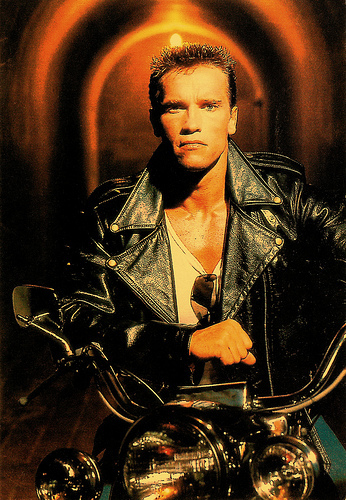
Vintage postcard, no. C 233.
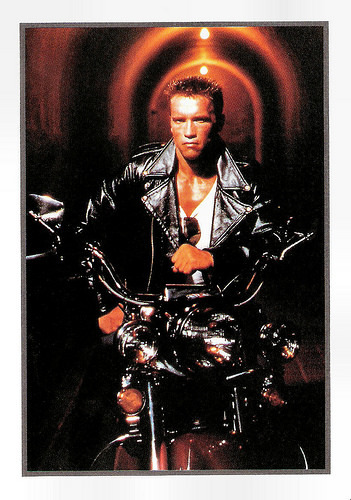
French postcard, no. 1088.

Vintage postcard, no. C 222.
Sources: Hal Erickson (AllMovie), (IMDb), Stuart Wood (IMDb), Jeremy Wheeler (AllMovie), Biography.com, Wikipedia, and .

Canadian Fan Club Post Card, no. PC 13.

American postcard by Classico San Francisco, no. 105-139. Photo: Carolco Pictures Inc. Publicity still for Terminator 2 Judgment Day (James Cameron, 1991).

British postcard by Minerva / Holmes McDougall Ltd., Edinburgh, no. PC 311.
The Austrian Oak
Arnold Alois Schwarzenegger was born in 1947 in the village Thal near the small Austrian town of Graz. His parents were Gustav and Aurelia Schwarzenegger.
His father, was an alcoholic police chief and one-time member of the Nazi Party, who clearly favoured Arnold's brother over his gangly, seemingly less athletic younger son. Gustav is reported to have beaten and intimidated Arnold and pitted his two boys against one another. Schwarzenegger would later refuse to attend the funeral of his father, who died in 1972, or his brother, who was killed in a car crash in 1971.
Gustav wanted Arnold to become a soccer player, but the 15-year-old opted for weight training. He frequented the local cinemas to see bodybuilding idols such as Reg Park and Steve Reeves on the big screen. In 1961, Schwarzenegger met former Mr. Austria Kurt Marnul, who invited him to train at the gym in Graz.
During his army service in 1965, Arnold won the Junior Mr. Europe contest. Arnold went on to win several European contests. This was his ticket to the U.S., where he billed himself for body-building exhibitions as ‘The Austrian Oak’. At age 20, he won the first of five Mr. Universe titles, and three years later, he captured his first Mr. Olympia title. He would win the title a total of seven times.
Hal Erickson at AllMovie : “Though his thick Austrian accent and slow speech patterns led some to believe that the Austrian Oak was shy a few leaves, Schwarzenegger was, in fact, a highly motivated and intelligent young man. After graduating from the University of Wisconsin with a degree in business and economics, he invested his contest earnings in real estate and a mail-order bodybuilding equipment company.”
At 21, Schwarzenegger was a millionaire via shrewd investments and decided to try acting. Producers were impressed by his physique but not by his last name, so he made his film debut with a dubbed voice and as Arnold Strong in Hercules in New York (Arthur A. Seidelman, 1970), a low-budget parody of the sword and sandal epics of Arnold’s youth.
He reverted to his own name for Stay Hungry (Bob Rafelson, 1976), with Jeff Bridges. For his part, he was awarded a Golden Globe for New Male Star of the Year. Then he achieved stardom as ‘himself’ in Pumping Iron (George Butler, Robert Fiore, 1977) about a group of men training for the Mr. Olympia contest. Arnold had already won the title six times before, and was training for his seventh victory before retiring to fully pursue his acting career.
In The Villain (Hal Needham, 1979), a cartoon-like Western parody, he played ‘Handsome Stranger,’ exhibiting a gift for understated. In 1980, he starred opposite Loni Anderson in the TV biopic The Jayne Mansfield Story (Dick Lowry, 1980) as Mansfield's husband, Mickey Hargitay.

French postcard by Humour à la Carte, Paris, no. ST-59. Photo: publicity still for Conan the Barbarian (John Milius, 1982).

Italian postcard by World Collection, no. P.c. 306. Photo: publicity still for Commando (Mark L. Lester, 1985).

Italian postcard by Vitorius Roma, no. 404. Photo: publicity still for Commando (Mark L. Lester, 1985).
A bona fide box-office draw
Arnold Schwarzenegger established himself as an action star with his role as the barbarian warrior Conan in the formidable Conan the Barbarian (John Milius, 1982) and its inferior though enjoyable sequel, Conan the Destroyer (Richard Fleischer, 1984).
As the murderous android title character in The Terminator (James Cameron, 1984), Schwarzenegger became a bona fide box-office draw. Made on a relatively modest budget, the high voltage action / science fiction thriller was incredibly successful worldwide, and began one of the most profitable film franchises in history. Schwarzenegger's catchphrase "I'll be baaaack" became part of popular culture around the world.
Then followed two of his best action films: Predator (John McTiernan, 1987) - an entertaining marriage of action and science fiction about a team of commandos hunted by an extra-terrestrial warrior in a South-American jungle, and Paul Verhoeven's wild and sublime Sci-Fi action film Total Recall (Paul Verhoeven, 1990).
Total Recall, loosely based on the Philip K. Dick story We Can Remember It for You Wholesale, tells the story of a construction worker who goes for virtual vacation memories of the planet Mars, but an unexpected and harrowing events force him to go to the planet for real - or does he?
Stuart Wood at IMDb : “Total Recall is without doubt Arnold Schwarzenegger's best movie since The Terminator. Arnold fits perfectly in the role of Doug Quaid (definitely his best acting in a movie to date) the confused construction worker and Ronny Cox provides his usual evil plotting arch bad-guy. The impressive visual effects are worth the movie's $100 million price tag, and Paul Verhoeven proved that, as with Robocop and Starship Troopers, sci-fi is where he does his best work.“
As Danny De Vito's unlikely pacifistic sibling in Twins (Ivan Reitman, 1988), Schwarzenegger received the praise of critics. In the police comedy Kindergarten Cop (Ivan Reitman, 1991), Schwarzenegger played a hard-bitten police detective who found his true life's calling as a schoolteacher.
Terminator 2: Judgment Day (James Cameron, 1991), wherein ‘Arnie’ exercised his star prerogative and insisted that the Terminator become a good guy, was the most expensive film ever made up to its time and became one of the biggest moneymakers. The actor's subsequent action films were equally as costly.
Hal Erickson: “sometimes the expenditures paid off, while other times the result was immensely disappointing - for the box-office disappointment Last Action Hero (1992), Schwarzenegger refreshingly took full responsibility, rather than blaming the failure on his production crew or studio.”

British postcard, no. 105. Publicity still for Raw Deal (John Irvin, 1986).

French postcard by Sonis, no. C. 129. Photo: Carolco International NV. Publicity still for Total Recall (Paul Verhoeven, 1990).

French postcard by Sonis, no. C. 130. Photo: Carolco International NV. Publicity still for Total Recall (Paul Verhoeven, 1990).
Mr. Freeze
Arnold Schwarzenegger is a rock-ribbed Republican despite his former marriage to JFK's niece, Maria Shriver, with whom he has four children. He was appointed by George Bush in 1990 as chairman of the President's Council of Physical Fitness and Sports, a job he took as seriously and with as much dedication as any of his films.
A much-publicised investment in the showbiz eatery Planet Hollywood increased the coffers in Schwarzenegger's already bulging bank account. Schwarzenegger then added directing to his many accomplishments, piloting a few episodes of the TV series Tales From the Crypt as well as the TV-movie Christmas in Connecticut (1992) with Dyan Cannon, a remake of the classic Christmas in Connecticut (Peter Godfrey, 1945) with Barbara Stanwyck.
Schwarzenegger bounced back from the disastrous Last Action Hero (John McTiernan, 1990) with True Lies (James Cameron, 1994), which was one of the major hits of that summer.
Following the success of True Lies, Schwarzenegger went back to doing comedy with Junior (Ivan Reitman, 1994), co-starring with Emma Thompson. The film met with critically mixed results, although it fared decently at the box office.
Schwarzenegger continued to alternate action with comedy with Eraser (Chuck Russell, 1996) and Jingle All the Way (Brian Levant, 1996). The latter proved to be both a critical bomb and a box-office disappointment. Schwarzenegger returned to action films with Batman & Robin (Joel Schumacher, 1997), in which he played the villain Mr. Freeze. Unfortunately the film proved to be a huge critical disappointment.

Dutch postcard by Film Freak Productions, no. FA 283, 1992. Photo: Carolco International N.V. Publicity still for Terminator 2: Judgment Day (James Cameron, 1991).

French postcard, no. S 118.

French postcard by Editions Humour à la Carte, Paris, no. ST-126.
The Governator
The turn of the century found Arnold Schwarzenegger's film career and box office prominence into decline. He made two millennial paranoia films, End of Days (Peter Hyams, 1999) and The 6th Day (Roger Spottiswoode, 2000), both failures. Collateral Damage (Andrew Davis, 2002) also failed to do well at the box office.
Fans rejoiced when Arnold resumed his role as a seriously tough cyborg in Terminator 3: Rise of the Machines (Jonathan Mostow, 2003). Jeremy Wheeler at AllMovie : “What T3 does effectively is bring back the mix of highly intense action, character-driven humor, and technological wizardry that the big screen had been lacking for more than a decade since Terminator 2: Judgment Day. There's a direct understanding of the series core dynamics, and once things kick in, there's no doubt that you're back in Terminator-land. Arnold Schwarzenegger eases back into the role effortlessly, bringing an understanding to the lovable cyborg that goes beyond simple line delivery and stoic screen presence.”
Though Schwarzenegger made a cameo in Around the World in 80 Days (Frank Coraci, 2004), his most notable role of the new millennium was political. In 2003 he became the governor of California, and ‘The Governator’ served two terms until 2011.
In 2010, Schwarzenegger was among the all-star cast of action-movie icons in The Expendables (Sylvester Stallone, 2010), an action thriller following a group of tough-as-nails mercenaries as they deal with the aftermath of a mission gone wrong. He reprised his role for The Expendables 2 (Simon West, 2012) and The Expendables 3 (Patrick Hughes, 2014).
The Last Stand (Kim Jee-woon, 2013) was his first leading role in 10 years. More recently he returned to the Terminator franchise in Terminator Genisys (Alan Taylor, 2015) and he produced and acted in the dramatic horror film Maggie (Henry Hobson, 2015). His most recently released film is the thriller Aftermath (Elliott Lester, 2017).

Vintage postcard, no. C 233.

French postcard, no. 1088.

Vintage postcard, no. C 222.
Sources: Hal Erickson (AllMovie), (IMDb), Stuart Wood (IMDb), Jeremy Wheeler (AllMovie), Biography.com, Wikipedia, and .
Published on May 13, 2017 22:00
Paul van Yperen's Blog
- Paul van Yperen's profile
- 13 followers
Paul van Yperen isn't a Goodreads Author
(yet),
but they
do have a blog,
so here are some recent posts imported from
their feed.



